Laird Connectivity BT2 TiWi-uB1 User Manual
LS Research, LLC TiWi-uB1
User Manual
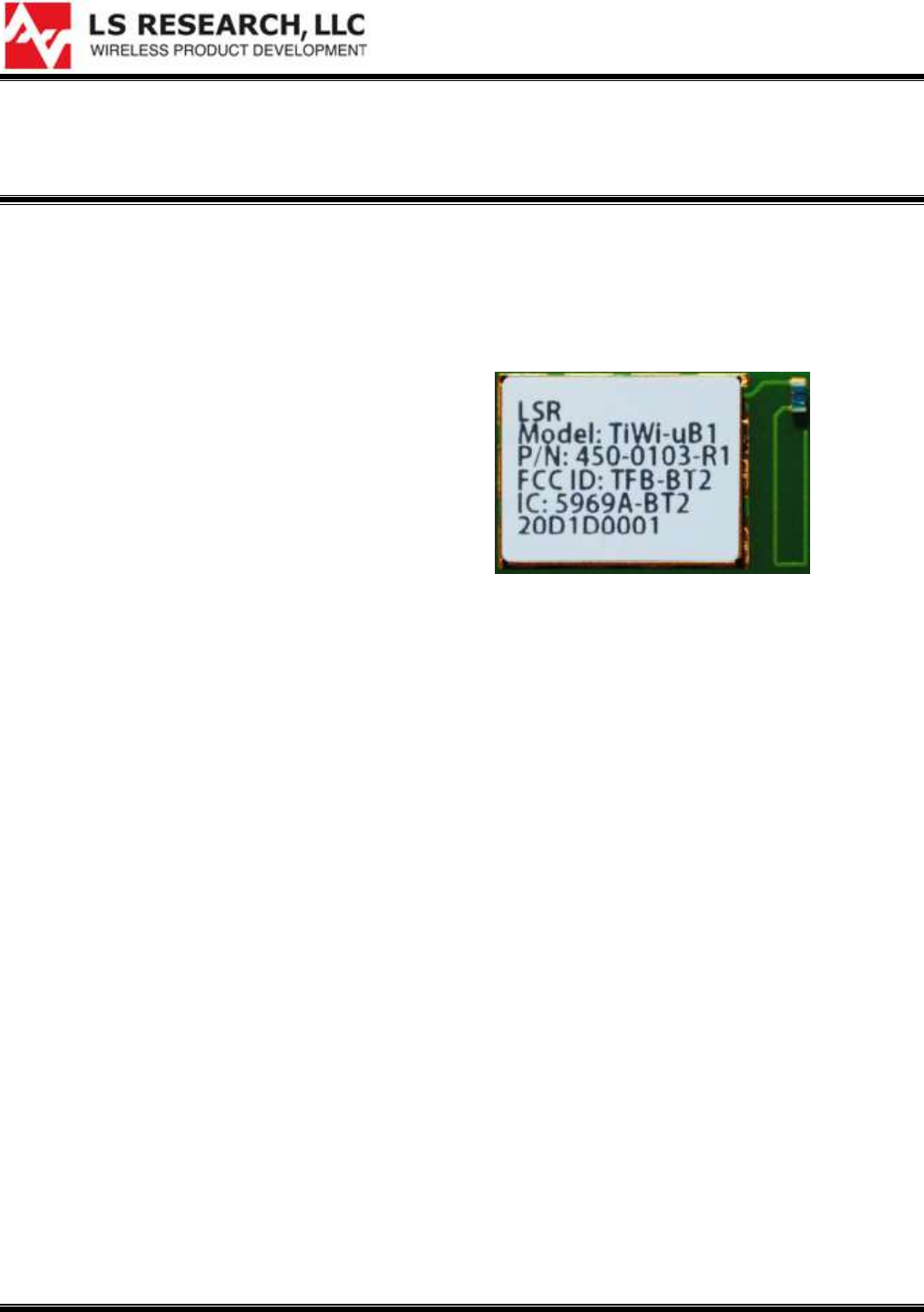
TiWi-uB1 Module
DATASHEET
The information in this document is subject to change without notice.
330-0132 Copyright © 2013 LS Research, LLC Page 1 of 22
TiWi-uB1 Bluetooth Smart (BLE) Module
FEATURES
Built in CC2541 single-chip Bluetooth
Smart (BLE 4.0) System-On-Chip
(SOC).
RF Output Power: 0 dBm (Class 3)
RF Receive Sensitivity: -92 dBm
Size: 11.6mm x 17.9 mm x 2.3 mm
Operating Voltage: 2.0V to 3.6V
Operating Temperature: -40 to +85o C
Worldwide Acceptance: FCC (USA), IC
(Canada), and CE (Europe)
REACH and RoHS compliant
Complete power-optimized stack,
including Controller and Host
o GAP – Central, Peripheral,
Observer, or Broadcaster (Including
Combination Roles)
o ATT/GATT – Client and Server
o SMP – AES-128 Encryption and
Decryption
o L2CAP
Multiple Configuration Options
o Single-Chip Configuration, Allowing
Applications to Run on CC2541
o Network Processor Interface for
Applications Running on an External
Microcontroller
APPLICATIONS
2.4 GHz Bluetooth Low Energy Systems
Human-Interface Devices (Keyboard,
Mouse, Remote Control)
Sports and Leisure Equipment
Mobile Phone Accessories
Consumer Electronics
DESCRIPTION
LSR would like to announce a low-cost and low-
power consumption module which has all of the
BluetoothSmart functionalities.
The TiWi-uB1 module fully supports the single
mode Bluetooth Low Energy operation, and the
output power can support class 3. The module
provides the ability to either put your entire
application into the integrated 8051
microcontroller, or use the module in Network
Processor mode in conjunction with the
microcontroller of your choice.
Need to get to market quickly? Not an expert in
Bluetooth Low Energy? Need a custom
antenna? Do you need help with your host
board? LS Research Design Services will be
happy to develop custom hardware or software,
or help integrate the design. Contact us at
sales@lsr.com or call us at 262-375-4400.
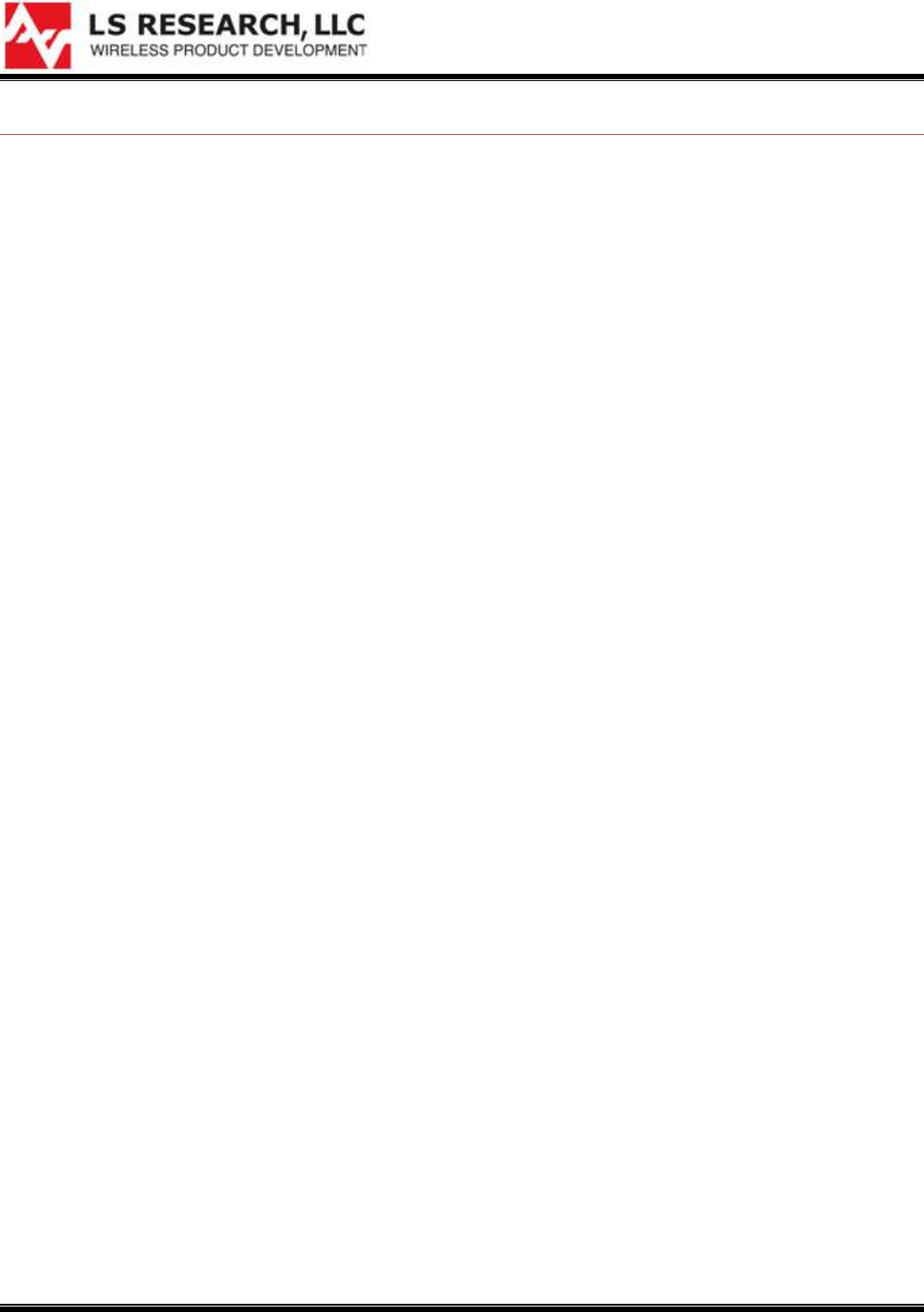
TiWi-uB1 Module
DATASHEET
The information in this document is subject to change without notice.
330-0132 Copyright © 2013 LS Research, LLC Page 2 of 22
TABLE OF CONTENTS
FEATURES .......................................................................................................................... 1
APPLICATIONS ................................................................................................................... 1
DESCRIPTION ..................................................................................................................... 1
FOOTPRINT AND PIN DEFINITIONS.................................................................................. 4
PIN DESCRIPTIONS ............................................................................................................ 5
ELECTRICAL SPECIFICATIONS ........................................................................................ 6
Absolute Maximum Ratings ....................................................................................................................... 6
Recommended Operating Conditions ...................................................................................................... 6
General Characteristics .............................................................................................................................. 6
General Specifications ............................................................................................................................... 7
DC Characteristics ...................................................................................................................................... 7
Current Consumption ................................................................................................................................. 8
CURRENT CONSUMPTION WITH DC to DC Converter ........................................................................... 8
RF Characteristics ...................................................................................................................................... 9
SLOW CLOCK (32 KHZ) SOURCE REQUIREMENTS ..................................................... 10
32.768-kHz EXTERNAL CRYSTAL OSCILLATOR................................................................................... 10
32-kHz INTERNAL RC OSCILLATOR ....................................................................................................... 11
SPI INTERFACE CHARACTERISTICS ............................................................................. 12
DEBUG INTERFACE CHARACTERISTICS ...................................................................... 14
AGENCY CERTIFICATIONS ............................................................................................. 16
AGENCY STATEMENTS ................................................................................................... 16
Federal Communication Commission Interference Statement ............................................................ 16
Industry Canada Statements.................................................................................................................... 17
OEM RESPONSIBILITIES TO COMPLY WITH FCC AND INDUSTRY CANADA
REGULATIONS ....................................................................................................... 18
OEM LABELING REQUIREMENTS FOR END-PRODUCT .............................................. 19
OEM END PRODUCT USER MANUAL STATEMENTS.................................................... 20
EUROPE ............................................................................................................................ 21
CE Notice ................................................................................................................................................... 21
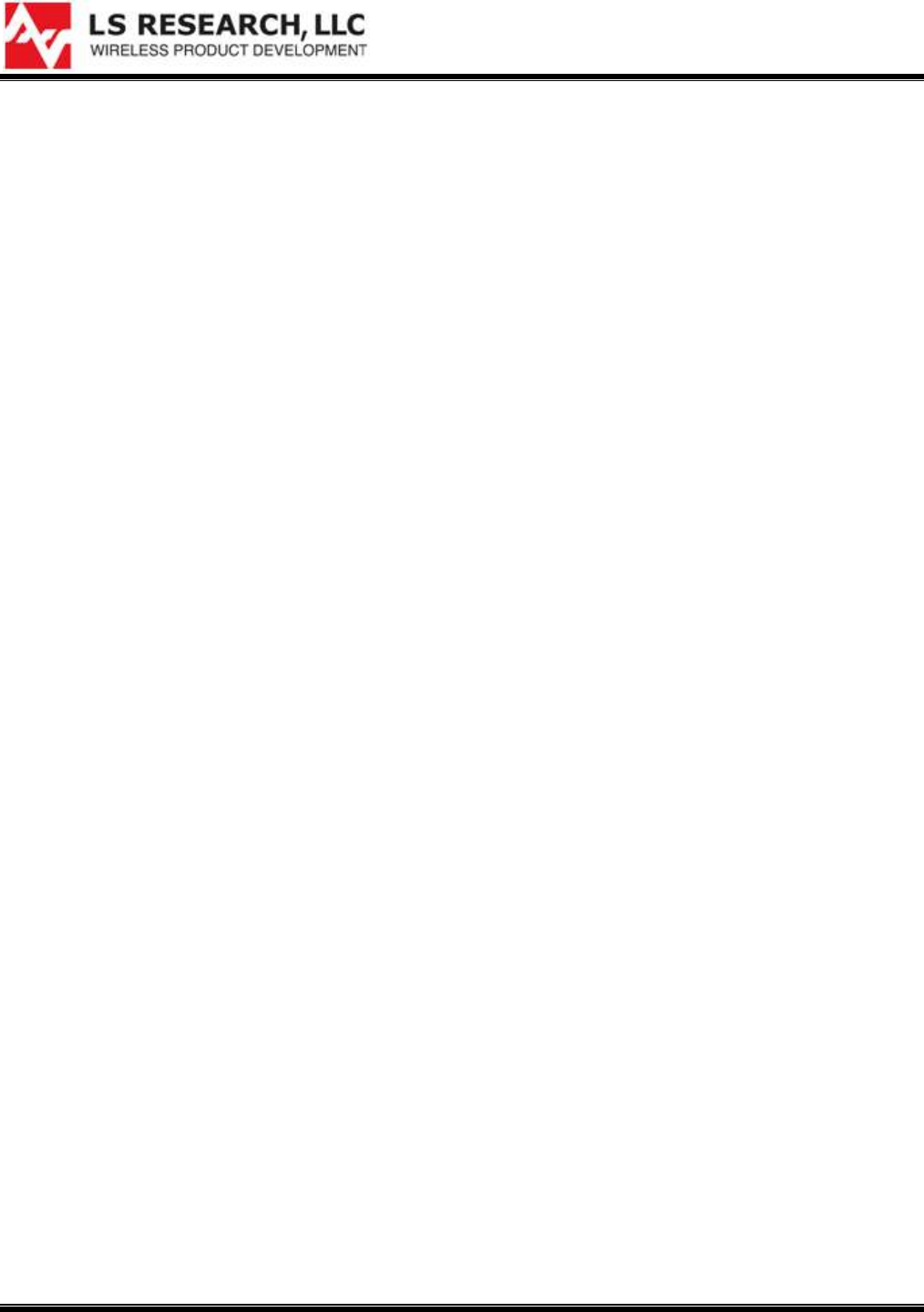
TiWi-uB1 Module
DATASHEET
The information in this document is subject to change without notice.
330-0132 Copyright © 2013 LS Research, LLC Page 3 of 22
Declaration of Conformity (DOC) ............................................................................................................ 21
BLUETOOTH CERTIFICATION ......................................................................................... 21
CONTACTING LS RESEARCH ......................................................................................... 22
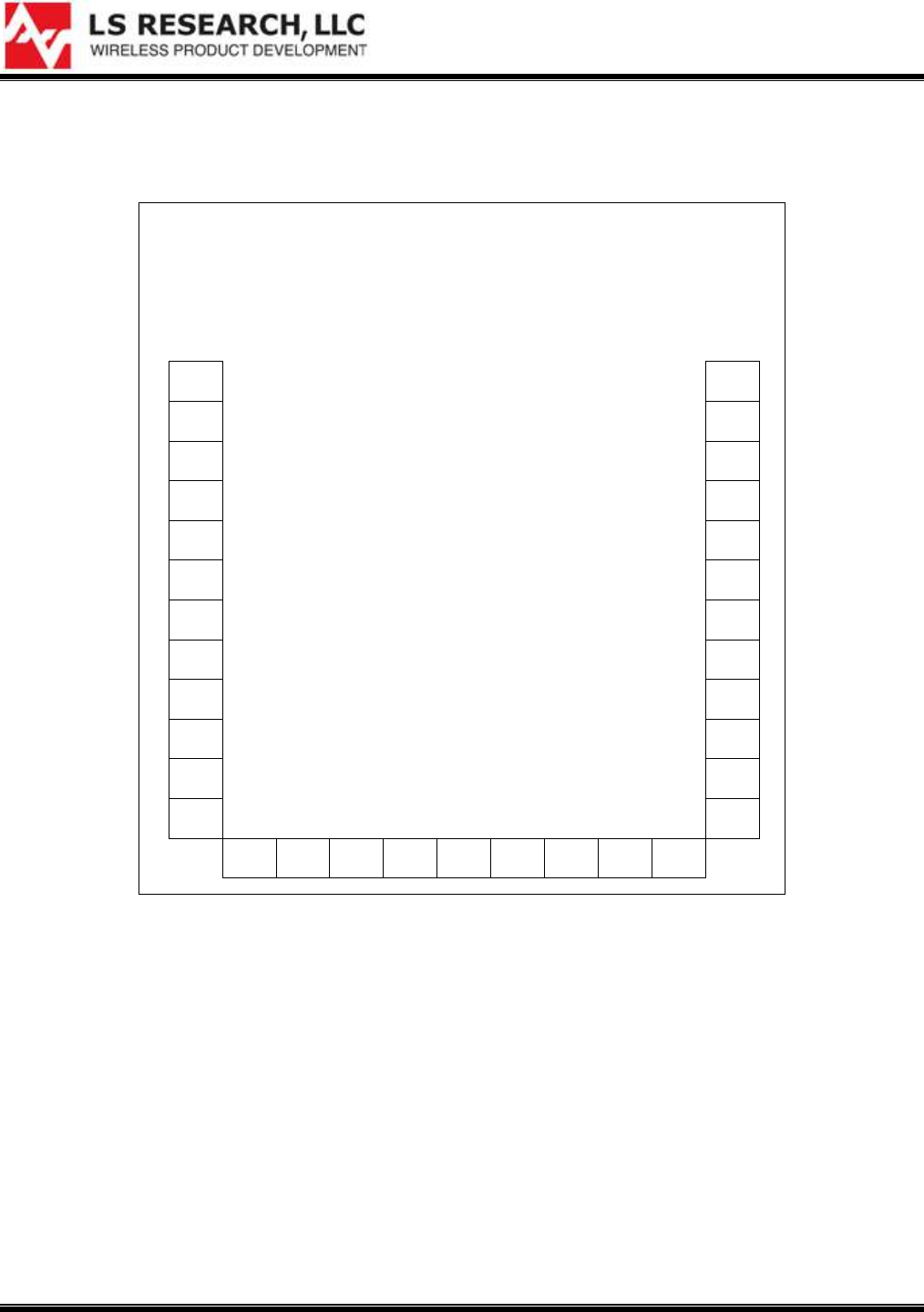
TiWi-uB1 Module
DATASHEET
The information in this document is subject to change without notice.
330-0132 Copyright © 2013 LS Research, LLC Page 4 of 22
FOOTPRINT AND PIN DEFINITIONS
1
33
2
32
3
31
4
30
5
29
6
28
7
27
8
26
9
25
10
24
11
23
12
22
13
14
15
16
17
18
19
20
21
Figure 1 TiWi-uB1 Module Footprint (Viewed From Top)
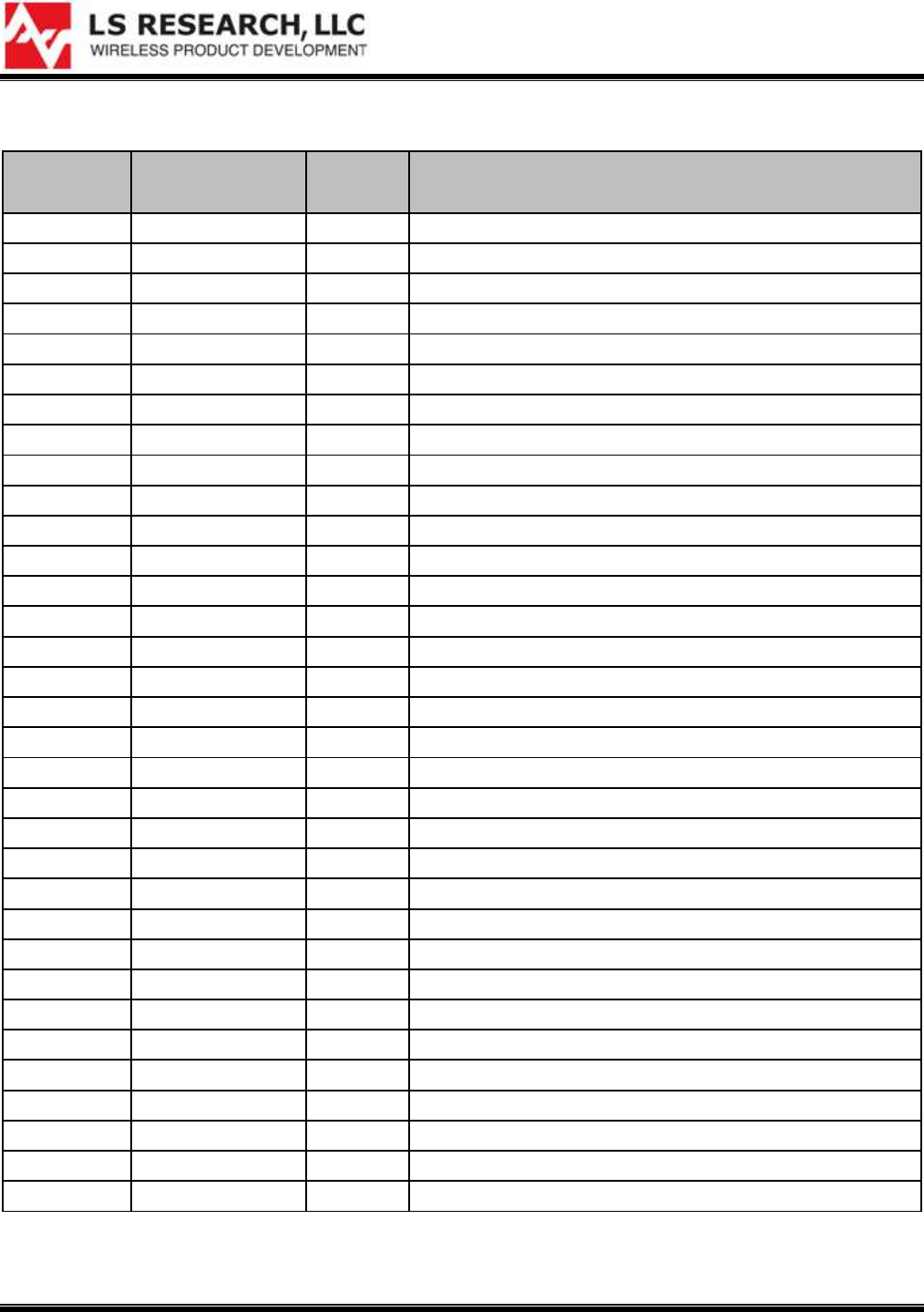
TiWi-uB1 Module
DATASHEET
The information in this document is subject to change without notice.
330-0132 Copyright © 2013 LS Research, LLC Page 5 of 22
PIN DESCRIPTIONS
Module Pin
Name
I/O Type
Description
1
RF OUT
RF
ANTENNA, 50 OHMS
2
GND
GND
GROUND
3
GND
GND
GROUND
4
OSC32K_Q1/P2_4
AI/DIO
GENERAL PURPOSE DIGITAL I/O
5
OSC32K_Q2/P2_3
AI/DIO
32KHZ GENERAL PURPOSE DIGITAL I/O
6
/RESET
DI
ACTIVE LOW RESET
7
DC/P2_2
DI/DIO
DEBUG CLOCK, GENERAL PURPOSE DIGITAL I/O
8
DD/P2_1
DIO
DEBUG DATA, GENERAL PURPOSE DIGITAL I/O
9
NC
-
NO CONNECT (DO NOT CONNECT)
10
NC
-
NO CONNECT (DO NOT CONNECT)
11
AVCC
PI
ANALOG POWER SUPPLY TO MODULE (2.0V – 3.6V)
12
DVCC
PI
DIGITAL POWER TO SUPPLY MODULE (2.0V – 3.6V)
13
P2_0
DIO
GENERAL PURPOSE DIGITAL I/O
14
SCL
DIO
I2C CLOCK, GENERAL PURPOSE DIGITAL I/O
15
SDA
DIO
I2C DATA, GENERAL PURPOSE DIGITAL I/O
16
P1_7
DIO
GENERAL PURPOSE DIGITAL I/O
17
P1_6
DIO
GENERAL PURPOSE DIGITAL I/O
18
P1_5
DIO
GENERAL PURPOSE DIGITAL I/O
19
P1_4
DIO
GENERAL PURPOSE DIGITAL I/O
20
P1_3
DIO
GENERAL PURPOSE DIGITAL I/O
21
P1_2
DIO
GENERAL PURPOSE DIGITAL I/O
22
GND
GND
GROUND
23
P1_1
DIO
GENERAL PURPOSE DIGITAL I/O
24
P1_0
DIO
GENERAL PURPOSE DIGITAL I/O
25
P0_7
DIO
GENERAL PURPOSE DIGITAL I/O, ANALOG INPUT
26
P0_6
DIO
GENERAL PURPOSE DIGITAL I/O, ANALOG INPUT
27
P0_5
DIO
GENERAL PURPOSE DIGITAL I/O, ANALOG INPUT
28
P0_4
DIO
GENERAL PURPOSE DIGITAL I/O, ANALOG INPUT
29
P0_3
DIO
GENERAL PURPOSE DIGITAL I/O, ANALOG INPUT
30
P0_2
DIO
GENERAL PURPOSE DIGITAL I/O, ANALOG INPUT
31
P0_1
DIO
GENERAL PURPOSE DIGITAL I/O, ANALOG INPUT
32
P0_0
DIO
GENERAL PURPOSE DIGITAL I/O, ANALOG INPUT
33
GND
GND
GROUND
PI = Power Input GND = Ground DI = Digital Input DO = Digital Output DIO = Digital Input/Output AI = Analog Input
RF = Bi-directional RF Port Note: See the Texas Instruments CC2541 datasheet and user guide for further details on the I/O.
Table 1 TiWi-uB1 Pin Descriptions
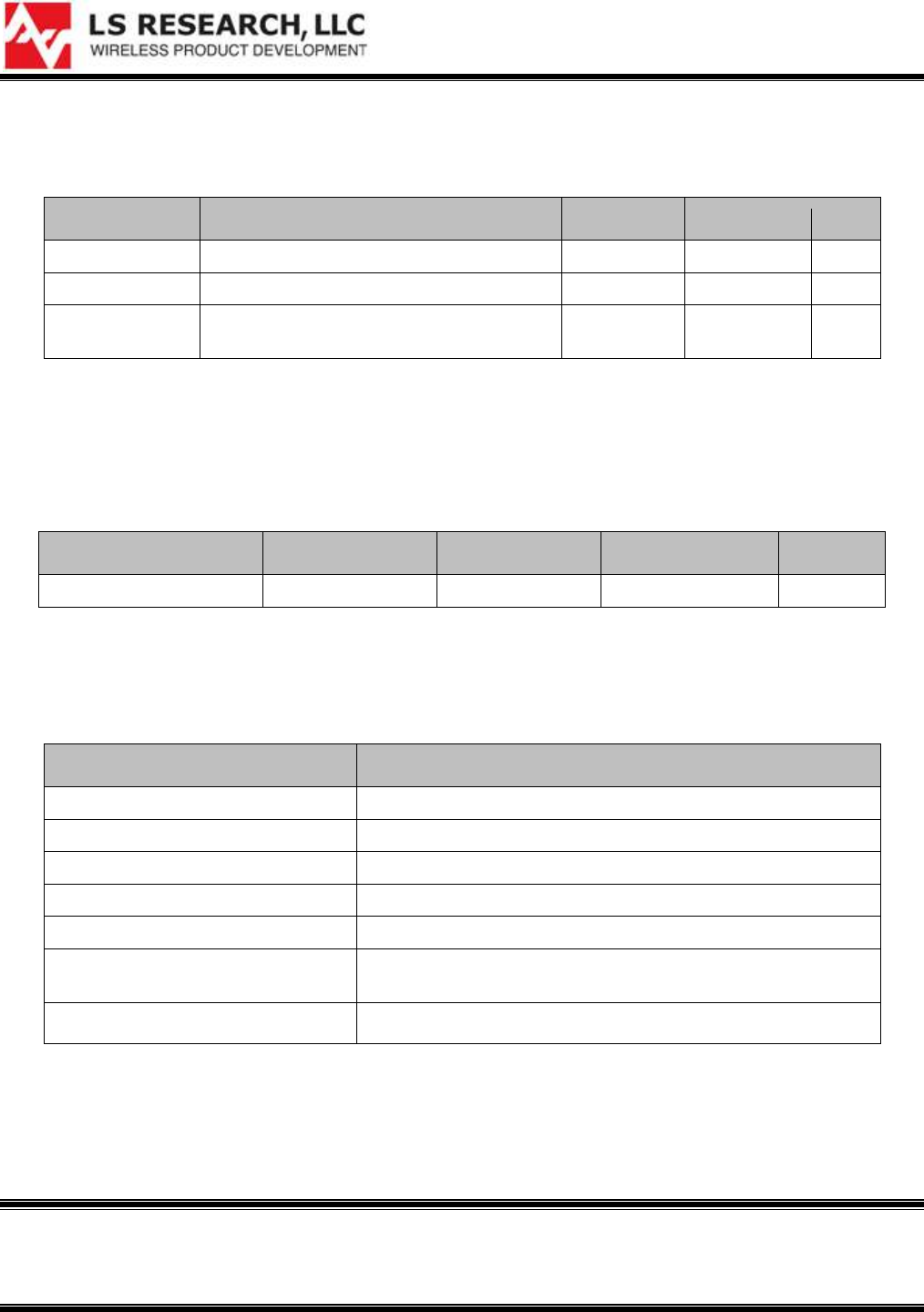
TiWi-uB1 Module
DATASHEET
The information in this document is subject to change without notice.
330-0132 Copyright © 2013 LS Research, LLC Page 6 of 22
ELECTRICAL SPECIFICATIONS
Absolute Maximum Ratings
Symbol
Description
Min
Max
Unit
DVCC
Digital Input Supply Voltage
-0.3
3.9
V
AVCC
Analog Input Supply Voltage
-0.3
3.9
V
VDIO
Voltage on any digital pin
-0.3
VDD + 0.3 ≤
3.9
V
Table 2 Absolute Maximum Ratings
1
Recommended Operating Conditions
Test conditions: Ambient Temp = 25°C
Symbol
Min
Typ
Max
Unit
VCC
2.0
3.3
3.6
V
Table 3 Recommended Operating Conditions
General Characteristics
Characteristic
Description
Model Name
TiWi-uB1
Product Description
Bluetooth Low Energy Wireless Module
Dimension
11.6 mm x 17.9 mm x 2.3 mm (W*L*T)
Operating temperature
-40°C to 85°C
Storage temperature
-40°C to 85°C
Humidity
Operating Humidity 10% to 95% Non-Condensing
Storage Humidity 5% to 95% Non-Condensing
Weight
0.18 g +/- 0.01g
Table 4 General Characteristics
1
Under no circumstances should exceeding the ratings specified in the Absolute Maximum Ratings section be
allowed. Stressing the module beyond these limits may result permanent damage to the module that is not
covered by the warranty.
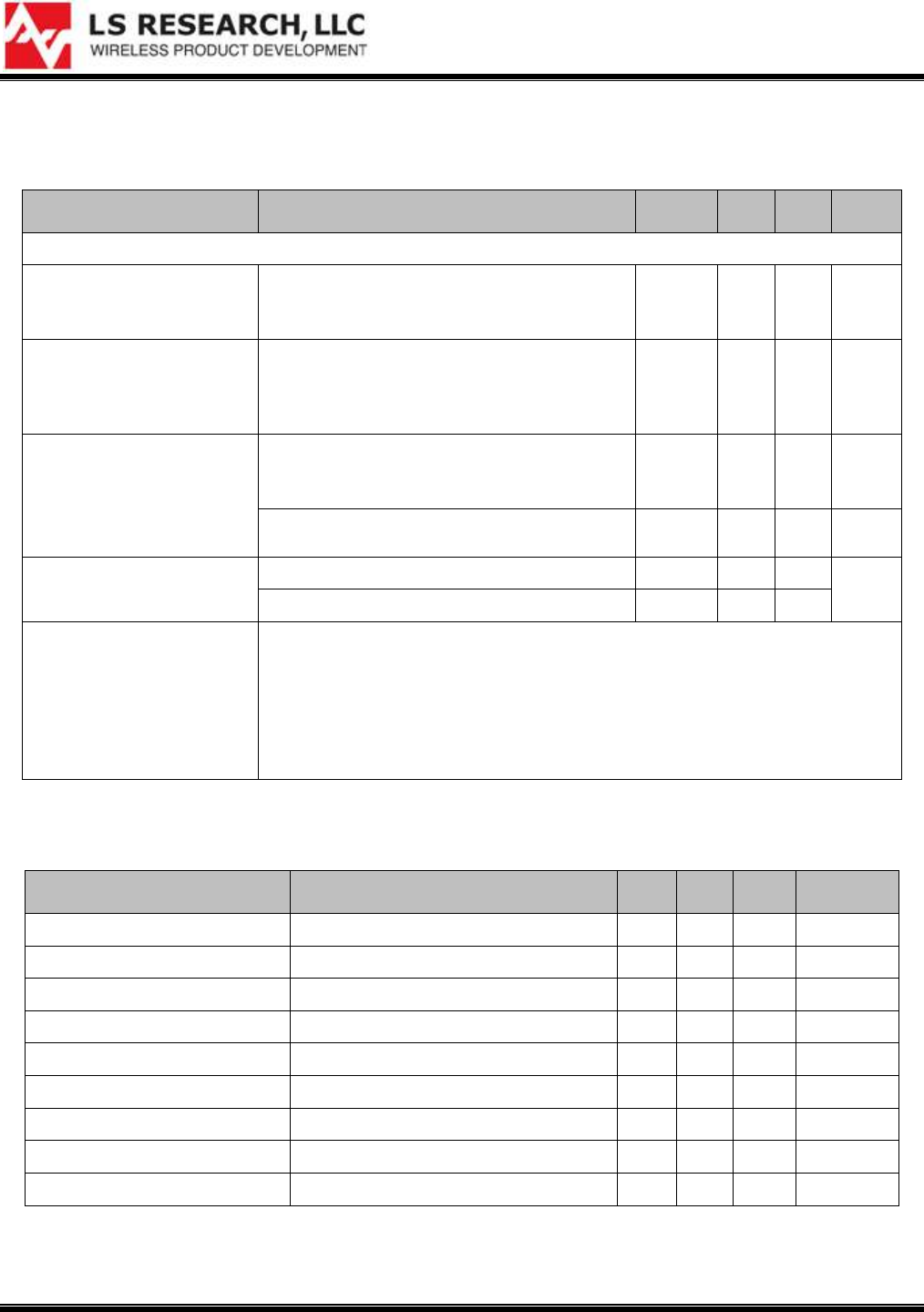
TiWi-uB1 Module
DATASHEET
The information in this document is subject to change without notice.
330-0132 Copyright © 2013 LS Research, LLC Page 7 of 22
General Specifications
Measured on LSR TiWi-uB1 EM reference design with TA = 25°C and VDD = 3 V
Parameter
Test Conditions
Min
Typ
Max
Unit
WAKE-UP AND TIMING
Power mode 1 → Active
Digital regulator on, 16-MHz RCOSC and
32-MHz crystal
oscillator off. Start-up of 16-MHz RCOSC
4
µS
Power mode 2 or 3 →
Active
Digital regulator off, 16-MHz RCOSC and
32-MHz crystal
oscillator off. Start-up of regulator and 16-
MHz RCOSC
120
µS
Active → TX or RX
Crystal ESR = 16 Ω. Initially running on 16-
MHz RCOSC,
with 32-MHz XOSC OFF
500
µS
With 32-MHz XOSC initially on
180
µS
RX/TX turnaround
Proprietary auto mode
130
µS
BLE mode
150
Data rate and
modulation format
2 Mbps, GFSK, 500-kHz deviation
2 Mbps, GFSK, 320-kHz deviation
1 Mbps, GFSK, 250-kHz deviation
1 Mbps, GFSK, 160-kHz deviation
500 kbps, MSK (Proprietary RF Only)
250 kbps, GFSK, 160-kHz deviation
250 kbps, MSK (Proprietary RF Only)
Table 5 Bluetooth General Specifications
DC Characteristics
Parameter
Test Conditions
Min
Typ
Max
Unit
Logic-0 input voltage
0.5
V
Logic-1 input voltage
2.4
V
Logic-0 input current
Input equals 0 V
-50
50
nA
Logic-1 input current
Input equals VDD
-50
50
nA
I/O-pin pullup/pulldown resistors
20
kΩ
Logic-0 output voltage, 4- mA pins
Output load 4 mA
0.5
V
Logic-1 output voltage, 4-mA pins
Output load 4 mA
2.5
V
Logic-0 output voltage, 20- mA pins
Output load 20 mA
0.5
V
Logic-1 output voltage, 20-mA pins
Output load 20 mA
2.5
V
Table 6 Bluetooth General DC Characteristics
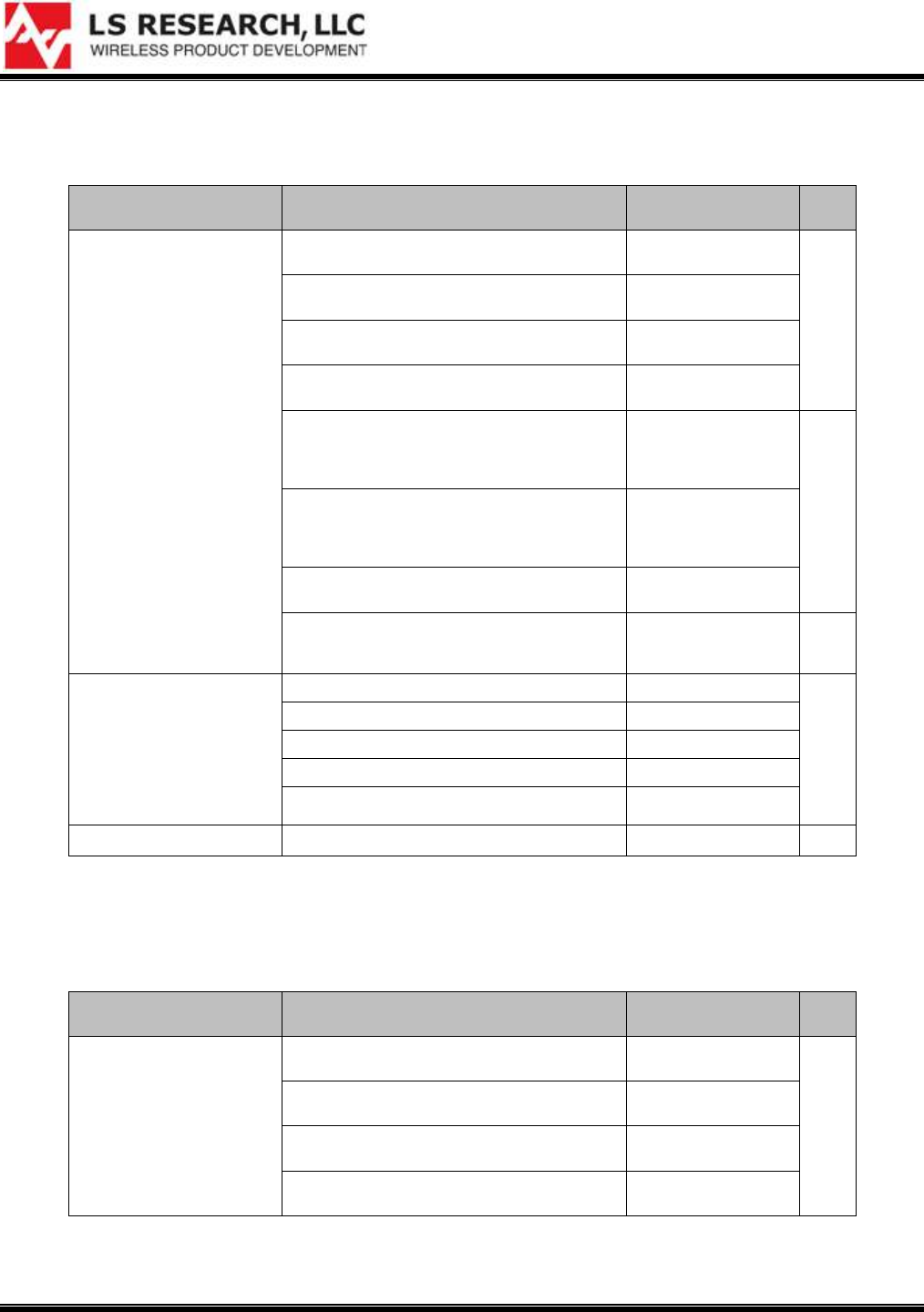
TiWi-uB1 Module
DATASHEET
The information in this document is subject to change without notice.
330-0132 Copyright © 2013 LS Research, LLC Page 8 of 22
Current Consumption
Measured on LSR TiWiuB1 EM reference design with TA = 25°C, VDD = 3 V, fc = 2440 MHz. LEDs disabled, DC to DC disabled
Mode
Description
Average Current
Unit
Icore Core current
consumption
RX mode, standard mode, no peripherals active,
low MCU activity
17.9
mA
RX mode, high-gain mode, no peripherals active,
low MCU activity
20.2
TX mode, –20 dBm output power, no peripherals
active, low MCU activity
16.8
TX mode, 0 dBm output power, no peripherals
active, low MCU activity
18.2
Power mode 1. Digital regulator on; 16-MHz
RCOSC and 32-MHz crystal oscillator off; 32.768-
kHz XOSC, POR, BOD and sleep timer active;
RAM and register retention
270
µA
Power mode 2. Digital regulator off; 16-MHz
RCOSC and 32-MHz crystal oscillator off; 32.768-
kHz XOSC, POR, and sleep timer active; RAM
and register retention
1
Power mode 3. Digital regulator off; no clocks;
POR active; 0.5 RAM and register retention
0.5
Low MCU activity: 32-MHz XOSC running. No
radio or peripherals. Limited flash access, no
RAM access.
6.7
mA
I peri Peripheral current
consumption
*Adds to core current Icore
for each peripheral unit
activated
Timer 1. Timer running, 32-MHz XOSC used
90
µA
Timer 2. Timer running, 32-MHz XOSC used
90
Timer 3. Timer running, 32-MHz XOSC used
60
Timer 4. Timer running, 32-MHz XOSC used
70
Sleep timer, including 32.753-kHz RCOSC
0.6
ADC, when converting
1.2
mA
Table 7 Bluetooth General DC Characteristics
CURRENT CONSUMPTION WITH DC to DC Converter
Measured on LSR TiWiuB1 EM reference design with TA = 25°C, VDD = 3 V, fc = 2440 MHz. LEDs disabled, DC to DC
Enabled 1 Mbsp, GFSK, 250-kHz deviation, Bluetooth™ low energy Mode, 1% BER
Mode
Description
Average Current
Unit
Current consumption
RX mode, standard mode, no peripherals active,
low MCU activity
14.7
mA
RX mode, high-gain mode, no peripherals active,
low MCU activity
16.7
TX mode, –20 dBm output power, no peripherals
active, low MCU activity
13.1
TX mode, 0 dBm output power, no peripherals
active, low MCU activity
14.3
Table 8 Bluetooth Power Consumption
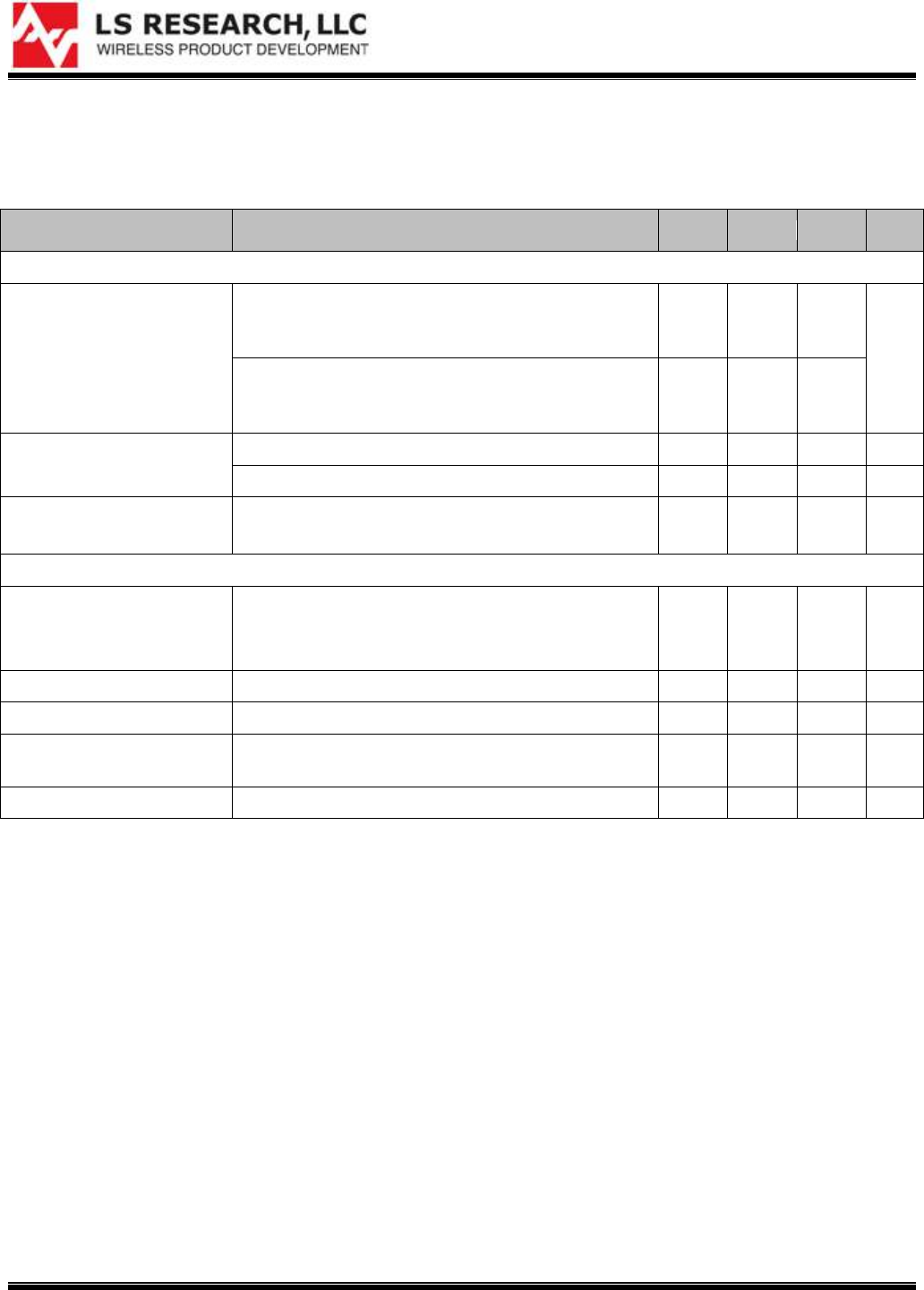
TiWi-uB1 Module
DATASHEET
The information in this document is subject to change without notice.
330-0132 Copyright © 2013 LS Research, LLC Page 9 of 22
RF Characteristics
Measured on LSR TiWiuB1 EM reference design with TA = 25°C, VDD = 3 V, fc = 2440 MHz. LEDs disabled, DC to DC
disabled, measured at RF connecter.
Parameter
Test Conditions
Min
Typ
Max
Unit
TRANSMIT SECTION
Output Power
Measured on LSR TiWiuB1 450-0106 EM
reference design at RF connector using maximum
recommended output power setting
0
dBm
Measured on LSR TiWiuB1 450-0106 EM
reference design at RF connector using minimum
recommended output power setting
-20
Spurious emission
conducted measurement
f < 1 GHz
-52
dBm
f > 1 GHz
-48
dBm
RF frequency range
Programmable in 1-MHz steps
2379
2496
MHz
RECEIVE SECTION
Receiver sensitivity(1) (2)
1 Mbps, GFSK, 250-kHz Deviation, Bluetooth low
energy Mode, 0.1% BER
-94
dBm
Saturation(2)
BER < 0.1%
5
dBm
Co-channel rejection (2)
Wanted signal –67 dBm
-6
dB
Frequency error tolerance
Including both initial tolerance and drift. Sensitivity
better than -67dBm, 250 byte payload. BER 0.1%
-250
250
KHz
Intermodulation (2)
Minimum interferer level
-36
dBm
Table 9 Bluetooth RF Characteristics
1. The receiver sensitivity setting is programmable using a TI BLE stack vendor-specific API command. The default value is standard
mode.
2. Results based on standard-gain mode.
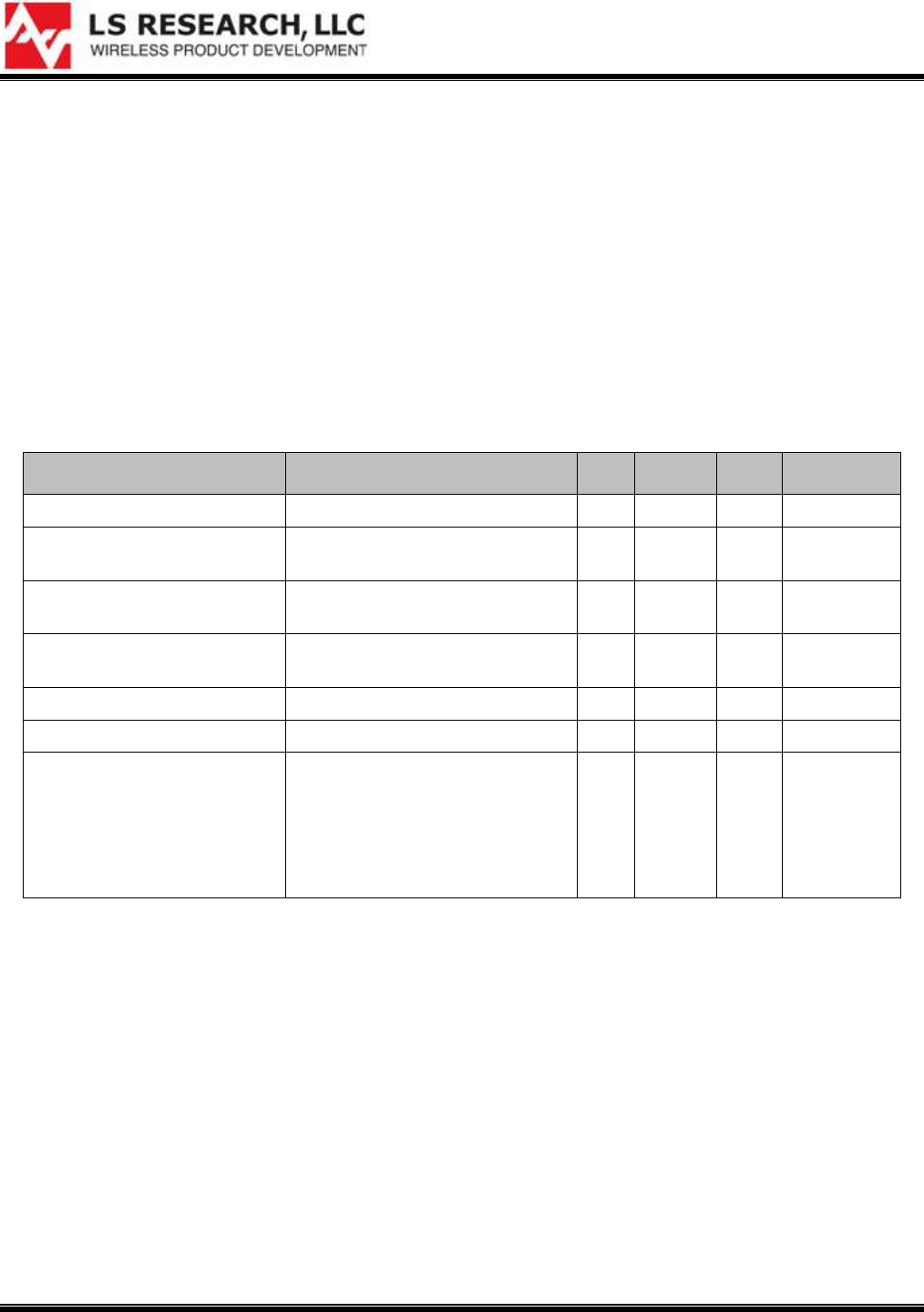
TiWi-uB1 Module
DATASHEET
The information in this document is subject to change without notice.
330-0132 Copyright © 2013 LS Research, LLC Page 10 of 22
SLOW CLOCK (32 KHZ) SOURCE REQUIREMENTS
Two 32-kHz oscillators are available in the device as clock sources for the 32-kHz clock:
• 32-kHz XOSC – External Crystal Oscillator
• 32-kHz RCOSC – Internal RC Oscillator
By default, after a reset, the 32-kHz RCOSC is enabled and selected as the 32-kHz clock source. The
RCOSC consumes less power, but is less accurate compared to the 32-kHz XOSC. The chosen 32-kHz
clock source drives the Sleep Timer, generates the tick for the Watchdog Timer, and is used as a strobe in Timer
2 to calculate the Sleep Timer sleep time.
The crystal is required for accurate sleep timing, so it is only needed to for the module be BLE certified when
using low power modes.
32.768-kHz EXTERNAL CRYSTAL OSCILLATOR
Characteristic
Condition
Min
Typ
Max
Unit
Crystal frequency
32768
Hz
Crystal frequency accuracy
requirement
-40
40
ppm
ESR Equivalent series
Resistance
6
60
Ω
C0 Crystal shunt
Capacitance
1
7
pF
CL Crystal load capacitance
10
16
pF
Start-up time
0.25
mS
Power-down guard time
The crystal oscillator must be in power
down for a guard time before it is used
again. This requirement is valid for all
modes of operation. The need for power-
down guard time can vary with crystal
type and load.
3
mS
Table 10 32 kHz External Clock Requirements
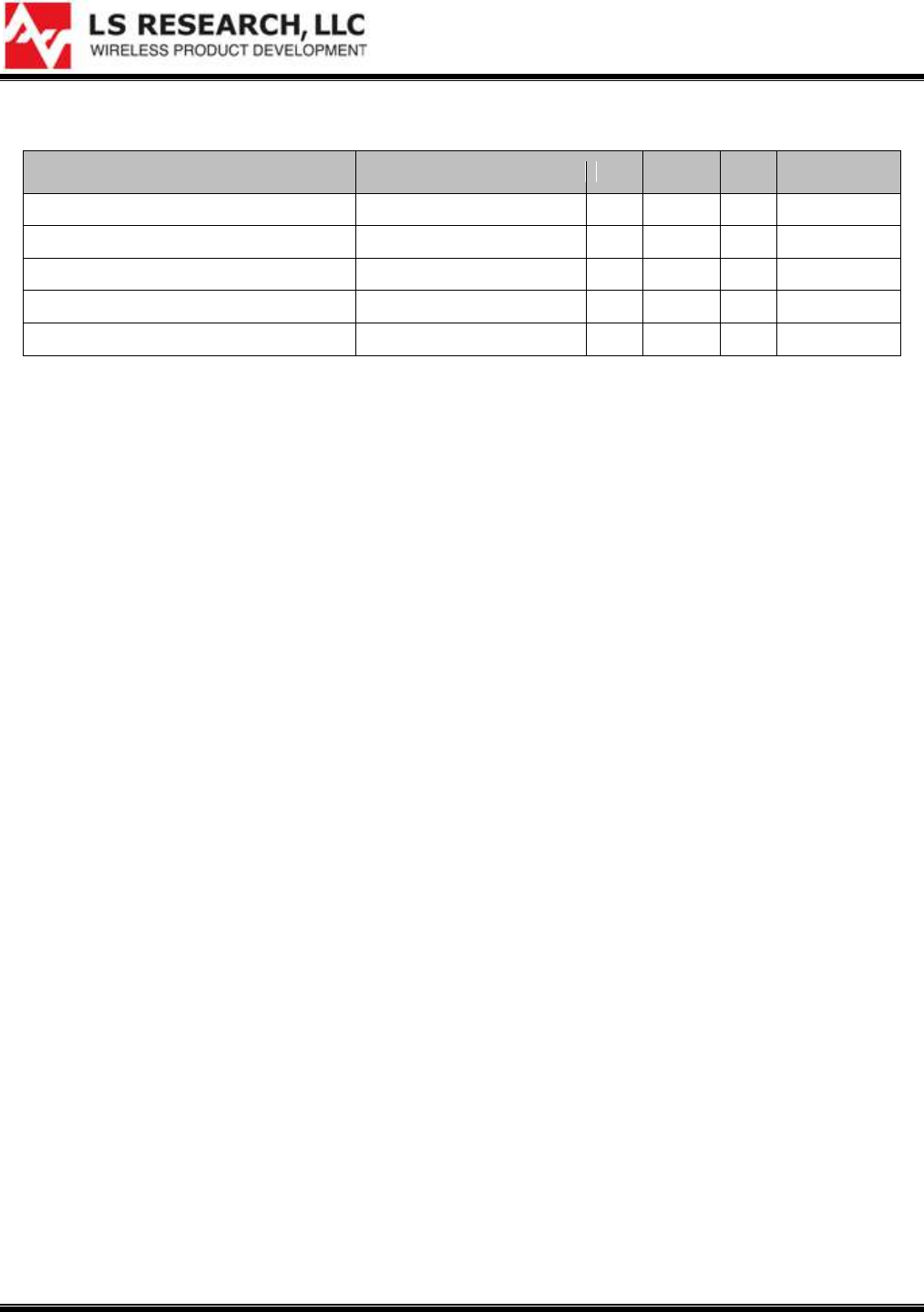
TiWi-uB1 Module
DATASHEET
The information in this document is subject to change without notice.
330-0132 Copyright © 2013 LS Research, LLC Page 11 of 22
32-kHz INTERNAL RC OSCILLATOR
Characteristic
Condition
Min
Typ
Max
Unit
Calibrated frequency (1)
32768
Hz
Frequency accuracy after calibration
-40
40
ppm
Temperature coefficient(2)
±0.2
%
Supply-voltage coefficient
3
%/V
Calibration time(3)
2
mS
Table 11 32 kHz Internal Clock Requirements
1) The calibrated 32-kHz RC oscillator frequency is 32-MHz divided by 977
2) Frequency drift when temperature changes after calibration
3) When the 32-kHz RC oscillator is enabled, it is calibrated when a switch from the 16-MHz RC oscillator to the 32-MHz crystal oscillator is
performed while SLEEPCMD.OSC32K_CALDIS is set to 0.
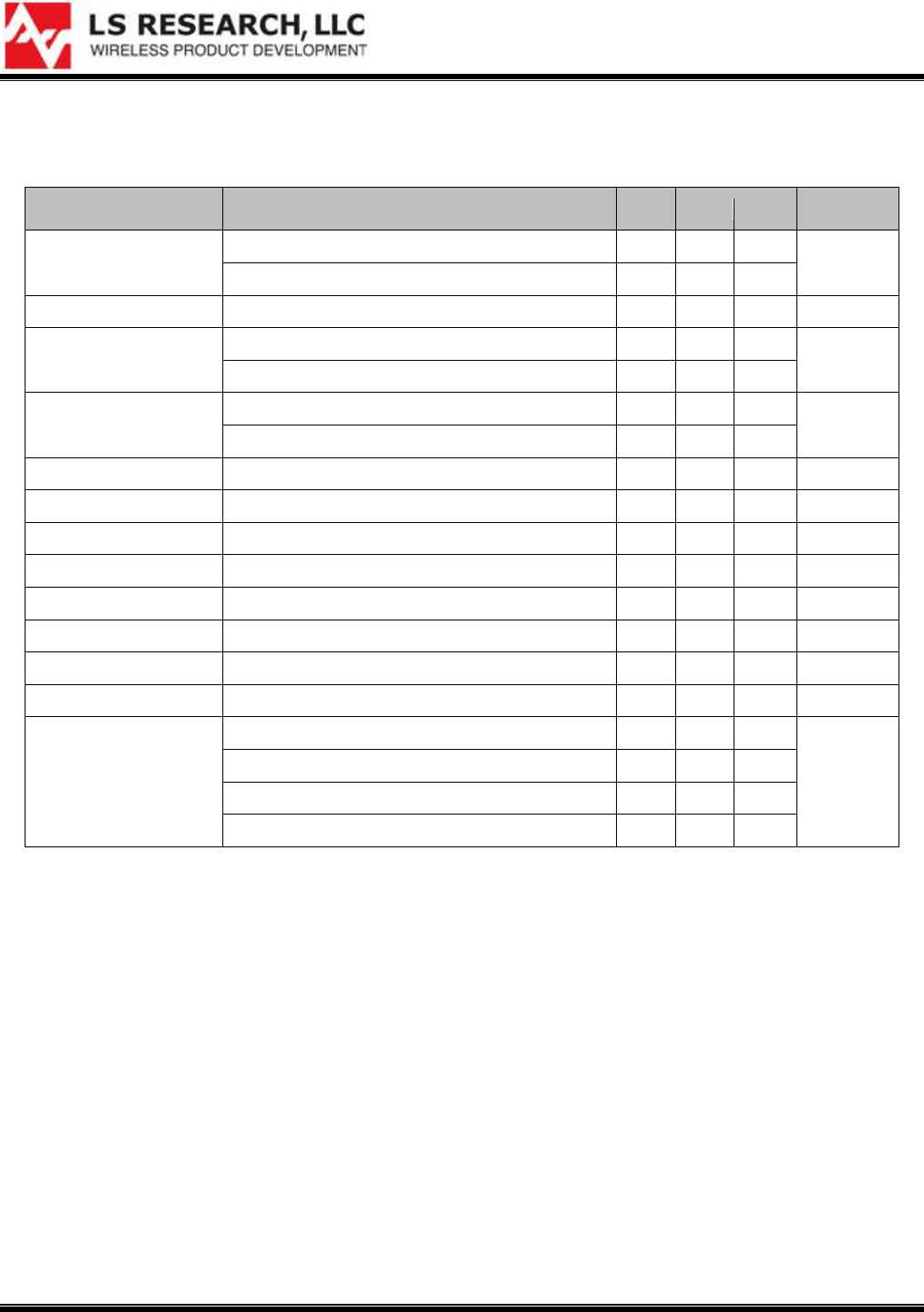
TiWi-uB1 Module
DATASHEET
The information in this document is subject to change without notice.
330-0132 Copyright © 2013 LS Research, LLC Page 12 of 22
SPI INTERFACE CHARACTERISTICS
TA = –40°C to 85°C, VDD = 2 V to 3.6 V
Characteristic
Condition
Min
Typ
Max
Unit
t1 SCK period
Master, RX and TX
250
nS
Slave, RX and TX
250
SCK duty cycle
Master
50%
t2 SSN low to SCK
Master
63
nS
Slave
63
t3 SCK to SSN high
Master
63
nS
Slave
63
T4 SCK to SSN high
Master, load = 10 pF
7
nS
t5 MOSI late out
Master, load = 10 pF
10
nS
t6 MISO setup
Master
nS
t7 MISO hold
Master
nS
SCK duty cycle
Slave
50%
t10 MOSI setup
Slave
nS
t11 MOSI hold
Slave
nS
t9 MISO late out
Slave, load = 10 pF
nS
Operating frequency
Master, TX only
8
MHz
Master, RX and TX
4
Slave, RX only
8
Slave, RX and TX
4
Table 12 SPI Timing
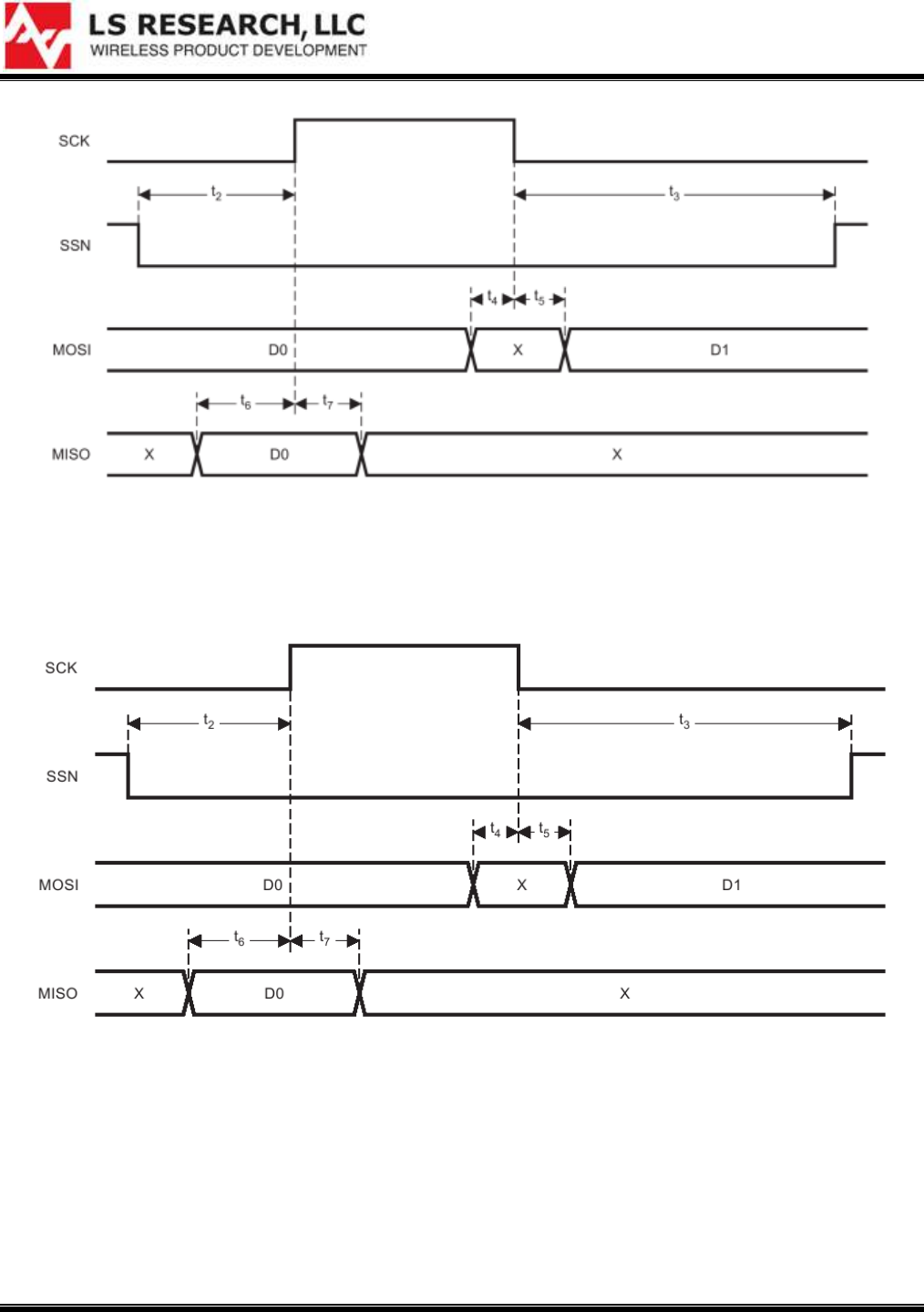
TiWi-uB1 Module
DATASHEET
The information in this document is subject to change without notice.
330-0132 Copyright © 2013 LS Research, LLC Page 13 of 22
Figure 2 SPI Master Timing
Figure 3 Slave Timing
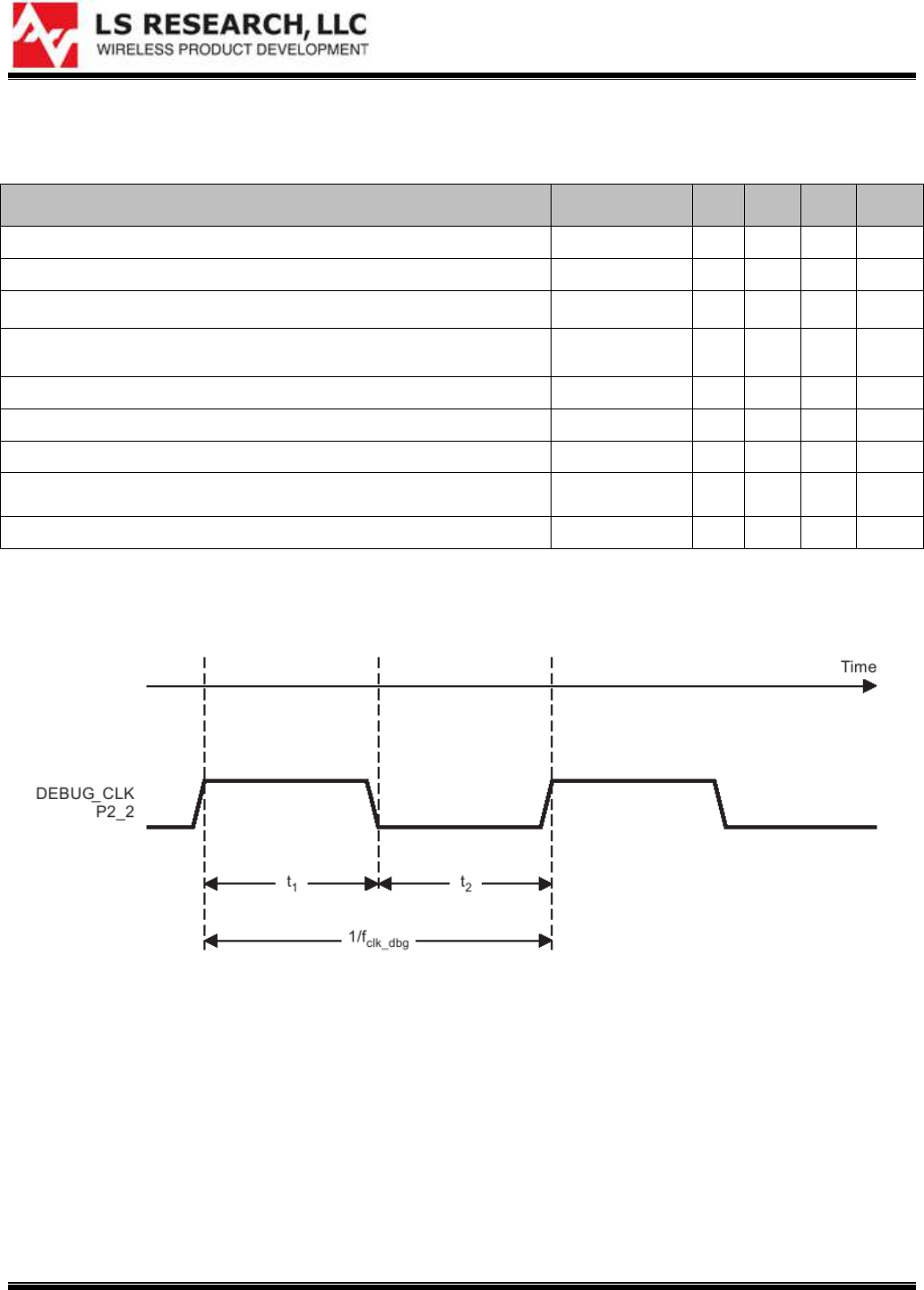
TiWi-uB1 Module
DATASHEET
The information in this document is subject to change without notice.
330-0132 Copyright © 2013 LS Research, LLC Page 14 of 22
DEBUG INTERFACE CHARACTERISTICS
TA = –40°C to 85°C, VDD = 2 V to 3.6 V
Characteristic
Condition
Min
Typ
Max
Unit
fclk_ dbg Debug clock frequency (see Figure 5)
12
MHz
t1 Allowed high pulse on clock (see Figure 5)
35
ns
t2 Allowed low pulse on clock (see Figure 5)
35
ns
t 3 EXT_RESET_N low to first falling edge on debug clock (see
Figure 7)
167
ns
t4 Falling edge on clock to EXT_RESET_N high (see Figure 7)
83
ns
t6EXT_RESET_N high to first debug command (see Figure 7)
83
ns
t6 Debug data setup (see Figure 6)
2
ns
t7 Debug data hold (see Figure 6)
4
ns
t8 Clock-to-data delay (see Figure 6)
Load = 10 pF
ns
Table 13 Debug Interface Timing
Figure 4 Slave Timing
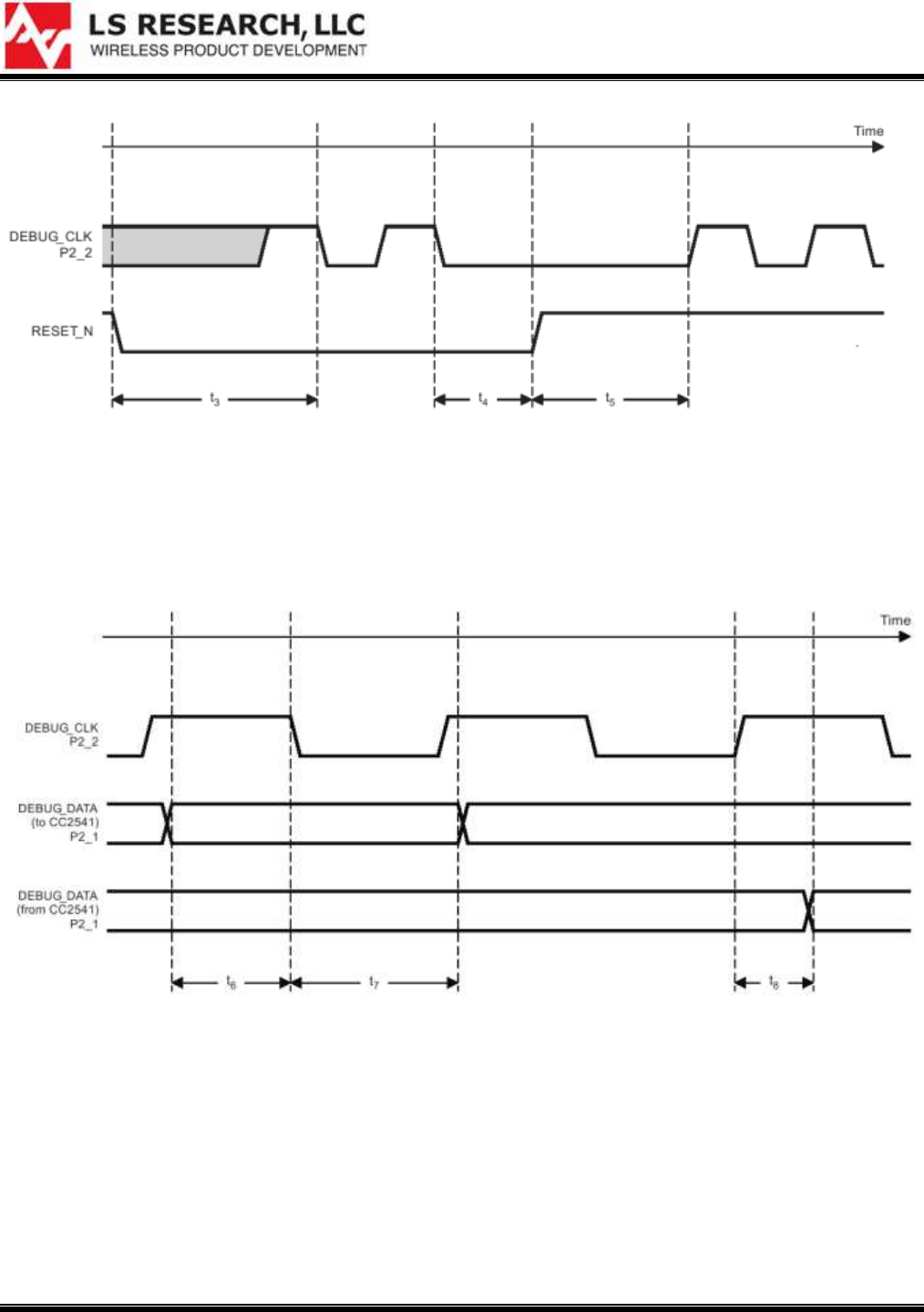
TiWi-uB1 Module
DATASHEET
The information in this document is subject to change without notice.
330-0132 Copyright © 2013 LS Research, LLC Page 15 of 22
Figure 5 Slave Timing
Figure 6 Slave Timing
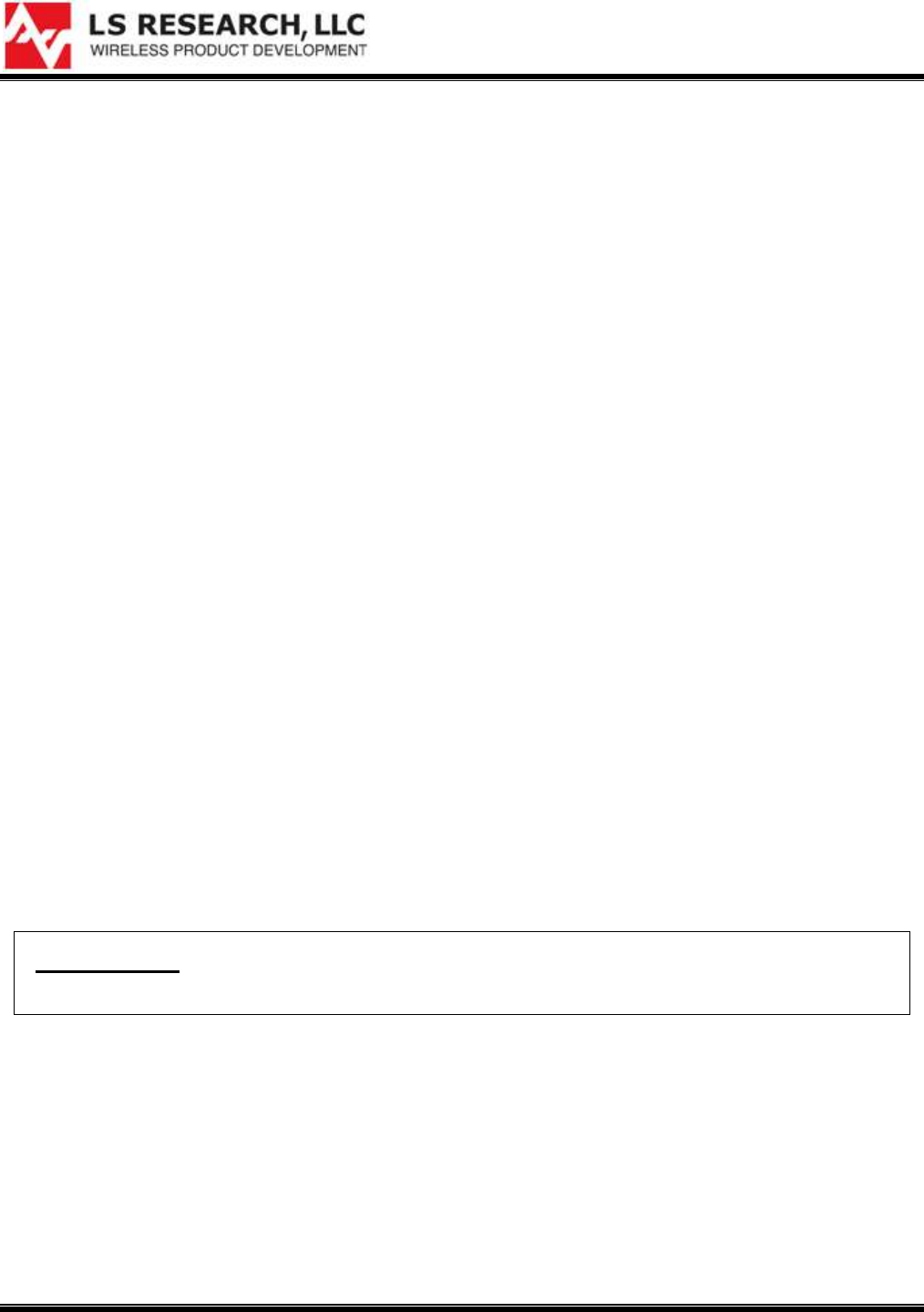
TiWi-uB1 Module
DATASHEET
The information in this document is subject to change without notice.
330-0132 Copyright © 2013 LS Research, LLC Page 16 of 22
AGENCY CERTIFICATIONS
FCC ID: TFB-BT2, 15.247
IC ID: 5969A-BT2, RSS 210
CE: Compliant to standards EN 60950-1, EN 300 328, and EN 301 489
AGENCY STATEMENTS
Federal Communication Commission Interference Statement
This equipment has been tested and found to comply with the limits for a Class B digital device,
pursuant to Part 15 of the FCC Rules. These limits are designed to provide reasonable protection
against harmful interference in a residential installation. This equipment generates uses and can radiate
radio frequency energy and, if not installed and used in accordance with the instructions, may cause
harmful interference to radio communications. However, there is no guarantee that interference will not
occur in a particular installation. If this equipment does cause harmful interference to radio or television
reception, which can be determined by turning the equipment off and on, the user is encouraged to try
to correct the interference by one of the following measures:
Reorient or relocate the receiving antenna.
Increase the separation between the equipment and receiver.
Connect the equipment into an outlet on a circuit different from that to which the receiver is
connected.
Consult the dealer or an experienced radio/TV technician for help.
This device complies with Part 15 of the FCC Rules. Operation is subject to the following two
conditions: (1) This device may not cause harmful interference, and (2) this device must accept any
interference received, including interference that may cause undesired operation.
This portable transmitter with its antenna complies with FCC/IC RF exposure limits for general
population / uncontrolled exposure.
FCC CAUTION: Any changes or modifications not expressly approved by the party
responsible for compliance could void the user's authority to operate this equipment.
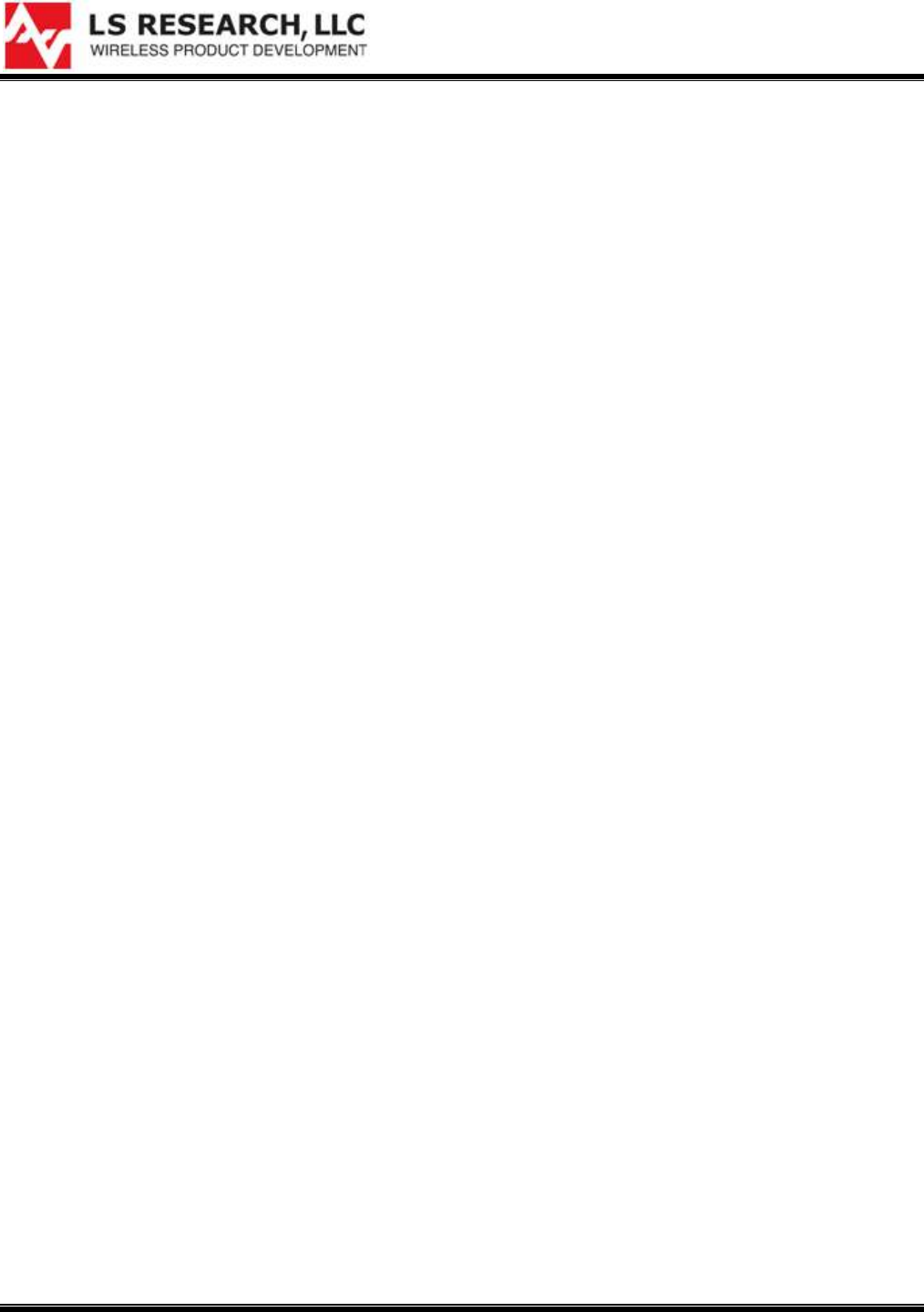
TiWi-uB1 Module
DATASHEET
The information in this document is subject to change without notice.
330-0132 Copyright © 2013 LS Research, LLC Page 17 of 22
Industry Canada Statements
This device complies with Industry Canada License-exempt RSS standard(s). Operation is subject to
the following two conditions: (1) this device may not cause interference, and (2) this device must accept
any interference, including interference that may cause undesired operation of the device.
To reduce potential radio interference to other users, the antenna type and its gain should be so
chosen that the equivalent isotropically radiated power (e.i.r.p.) is not more than that permitted for
successful communication.
This device has been designed to operate with the antenna(s) listed below, and having a maximum
gain of -4.2 dBi (PCB Trace) and 2.0dBi (LSR 2.4 GHz Dipole). Antennas not included in this list or
having a gain greater than -4.2 dBi and 2.0 dBi are strictly prohibited for use with this device. The
required antenna impedance is 50 ohms.
List of all Antennas Acceptable for use with the Transmitter
1) On module PCB trace antenna.
2) LS Research 001-0001 center-fed 2.4 GHz dipole antenna and LS Research 080-0001 U.FL to
Reverse Polarity SMA connector cable.
Cet appareil est conforme aux normes d'Industrie Canada exempts de licence RSS (s). L'opération
est soumise aux deux conditions suivantes: (1) cet appareil ne peut pas provoquer d'interférences
et (2) cet appareil doit accepter toute interférence, y compris les interférences qui peuvent causer un
mauvais fonctionnement de l'appareil.
Pour réduire le risque d'interférence aux autres utilisateurs, le type d'antenne et son gain doiventêtre
choisis de manière que la puissance isotrope rayonnée équivalente (PIRE) ne dépasse pascelle
permise pour une communication réussie.
Cet appareil a été conçu pour fonctionner avec l'antenne (s) ci-dessous, et ayant un gain maximum de
-4,2 dBi (PCB Trace) et 2,0 dBi (LSR 2.4 GHz Dipole). Antennes pas inclus dans cette liste ou
présentant un gain supérieur à -4,2 dBi et 2,0 dBi sont strictement interdits pour une utilisation avec cet
appareil. L'impédance d'antenne requise est de 50 ohms.
Liste de toutes les antennes acceptables pour une utilisation avec l'émetteur
1) Le module d'antenne PCB trace.
2) LS Research 001-0001 centre-fed 2,4 GHz antenne dipôle et LS Research 080-0001 U.FL pour
inverser câble connecteur SMA à polarité.
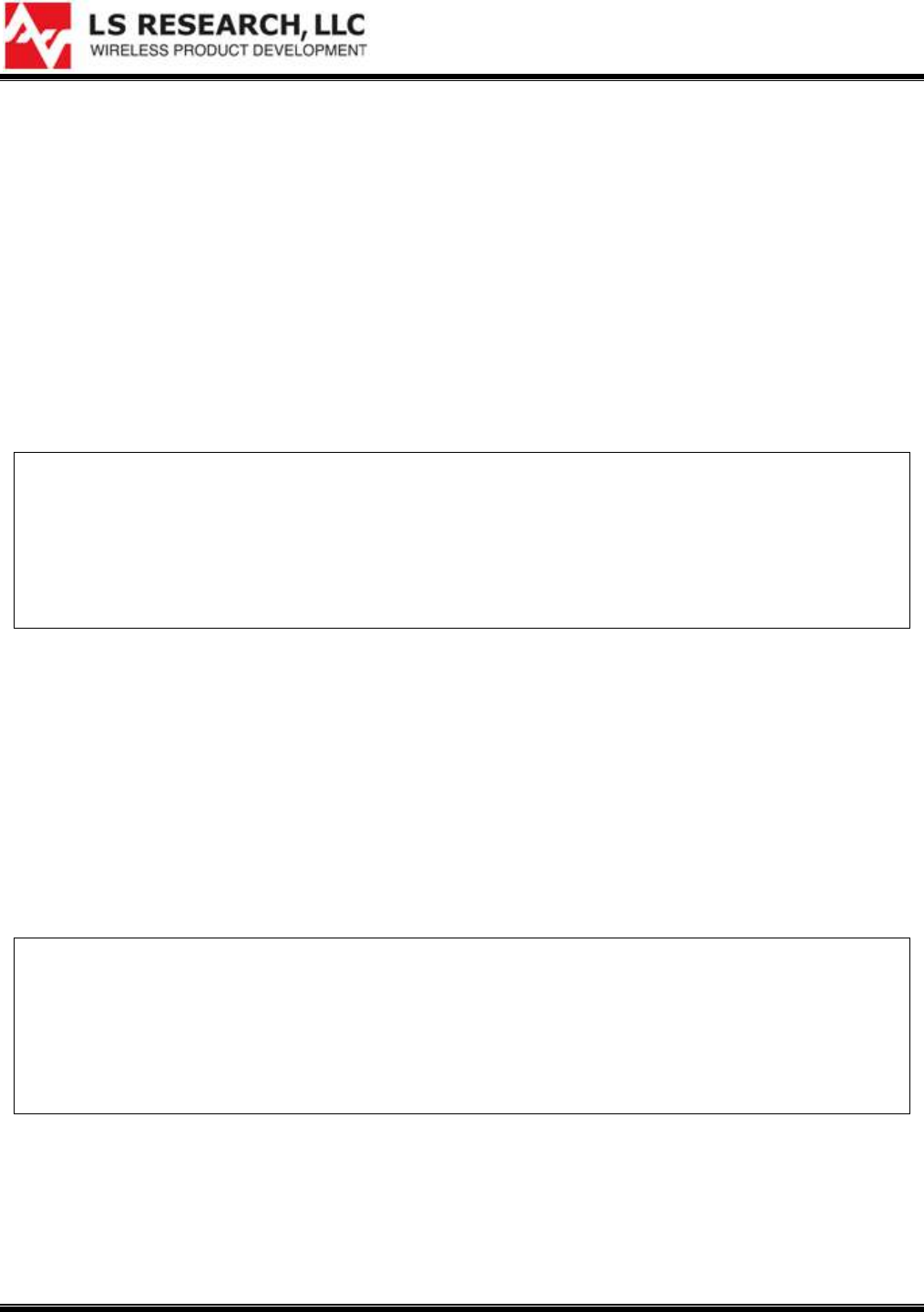
TiWi-uB1 Module
DATASHEET
The information in this document is subject to change without notice.
330-0132 Copyright © 2013 LS Research, LLC Page 18 of 22
OEM RESPONSIBILITIES TO COMPLY WITH FCC AND INDUSTRY CANADA
REGULATIONS
The TiWi-uB1 Module has been certified for integration into products only by OEM integrators under the
following conditions:
The antennas for this transmitter must not be co-located with any other transmitters except in
accordance with FCC and Industry Canada multi-transmitter procedures. Co-location means having a
separation distance of less than 20 cm between transmitting antennas.
As long as the two conditions above are met, further transmitter testing will not be required.
However, the OEM integrator is still responsible for testing their end-product for any additional
compliance requirements required with this module installed (for example, digital device
emissions, PC peripheral requirements, etc.).
IMPORTANT NOTE: In the event that these conditions cannot be met (for certain
configurations or co-location with another transmitter), then the FCC and Industry
Canada authorizations are no longer considered valid and the FCC ID and IC Certification
Number cannot be used on the final product. In these circumstances, the OEM integrator
will be responsible for re-evaluating the end product (including the transmitter) and
obtaining a separate FCC and Industry Canada authorization.
Le module de TiWi-uB1 a été certifié pour l'intégration dans des produits uniquement par des
intégrateurs OEM dans les conditions suivantes:
Les antennes pour ce transmetteur ne doit pas être co-localisés avec les autres émetteurs sauf en
conformité avec la FCC et Industrie Canada multi-émetteur procédures. Co-localisation des moyens
ayant une distance de séparation inférieure à 20 cm entre les antennes d'émission.
Tant que les deux conditions précitées sont réunies, les tests de transmetteurs supplémentaires ne
seront pas tenus. Toutefois, l'intégrateur OEM est toujours responsable de tester leur produit final pour
toutes les exigences de conformité supplémentaires requis avec ce module installé (par exemple, les
émissions appareil numérique, les exigences de périphériques PC, etc.)
NOTE IMPORTANTE: Dans le cas où ces conditions ne peuvent être satisfaites (pour
certaines configurations ou de co-implantation avec un autre émetteur), puis la FCC et
Industrie autorisations Canada ne sont plus considérés comme valides et l'ID de la FCC
et IC numéro de certification ne peut pas être utilisé sur la produit final. Dans ces
circonstances, l'intégrateur OEM sera chargé de réévaluer le produit final (y compris
l'émetteur) et l'obtention d'un distincte de la FCC et Industrie Canada l'autorisation.
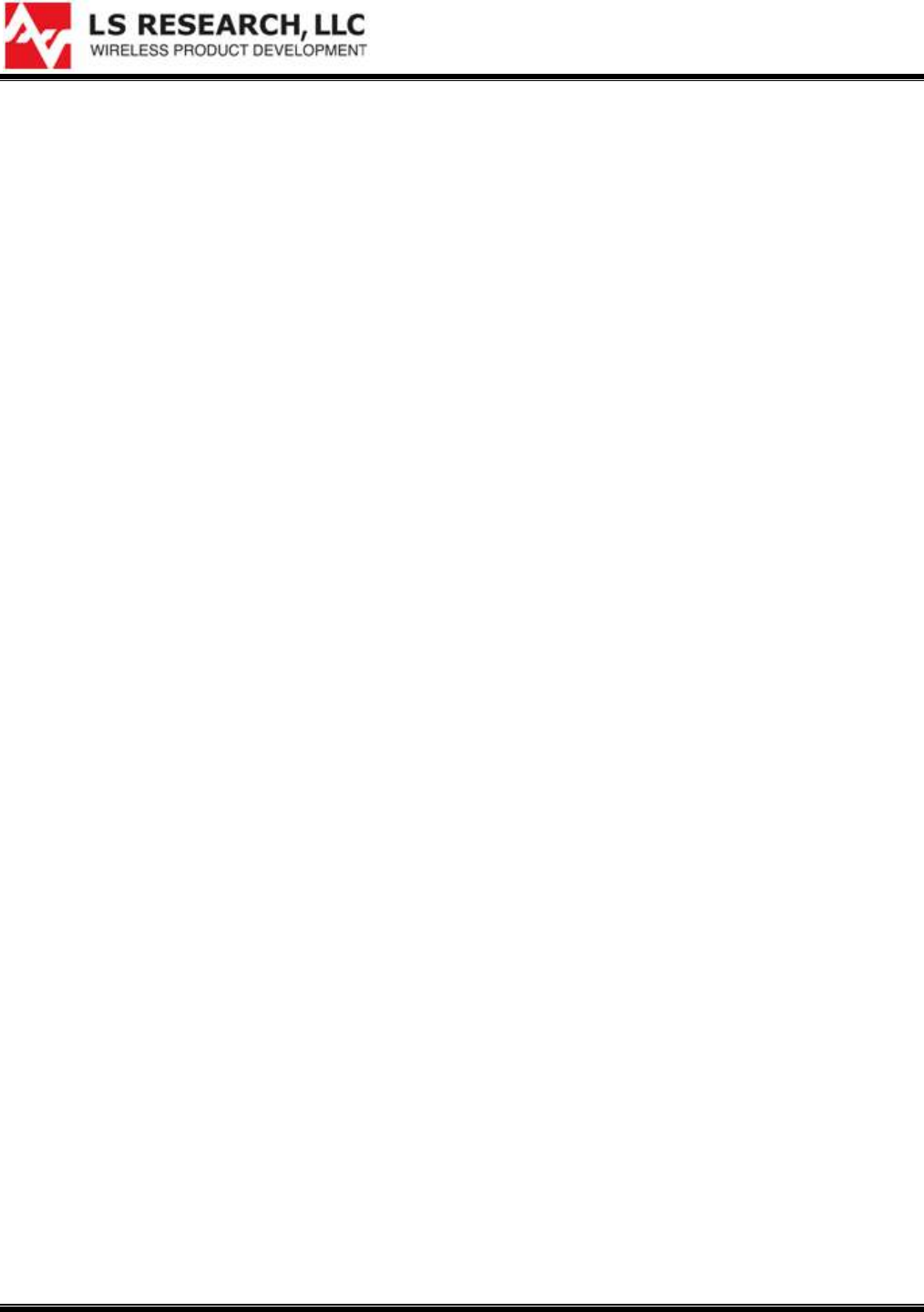
TiWi-uB1 Module
DATASHEET
The information in this document is subject to change without notice.
330-0132 Copyright © 2013 LS Research, LLC Page 19 of 22
OEM LABELING REQUIREMENTS FOR END-PRODUCT
The TiWi-uB1 module is labeled with its own FCC ID and IC Certification Number. The FCC ID and IC
certification numbers are not visible when the module is installed inside another device, as such the
end device into which the module is installed must display a label referring to the enclosed module.
The final end product must be labeled in a visible area with the following:
“Contains Transmitter Module FCC ID: TFB-BT2”
“Contains Transmitter Module IC: 5969A-BT2”
or
“Contains FCC ID: TFB-BT2”
“Contains IC: 5969A-BT2”
The OEM of the TiWi-uB1 Module must only use the approved antenna(s) listed above, which have
been certified with this module.
Le module de TiWi-uB1 est étiqueté avec son propre ID de la FCC et IC numéro de
certification. L'ID de la FCC et IC numéros de certification ne sont pas visibles lorsque le module
est installé à l'intérieur d'un autre appareil, comme par exemple le terminal dans lequel le module est
installé doit afficher une etiquette faisant référence au module ci-joint. Le produit final doit être
étiqueté dans un endroit visible par le suivant:
“Contient Module émetteur FCC ID: TFB-BT2"
“Contient Module émetteur IC: 5969A-BT2"
ou
“Contient FCC ID: TFB-BT2"
“Contient IC: 5969A-BT2"
Les OEM du module TiWi-uB1 ne doit utiliser l'antenne approuvée (s) ci-dessus, qui ont été
certifiés avec ce module.
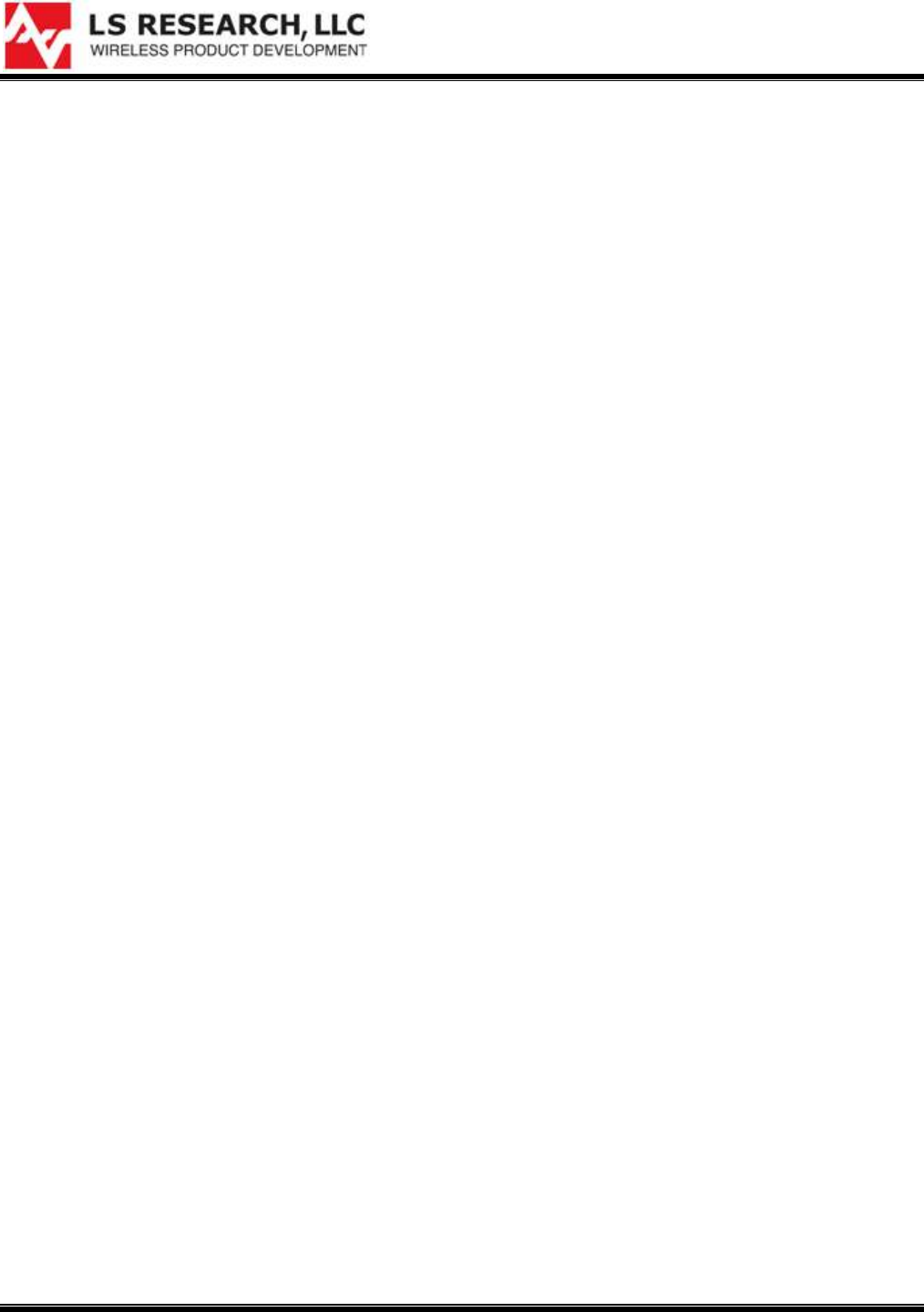
TiWi-uB1 Module
DATASHEET
The information in this document is subject to change without notice.
330-0132 Copyright © 2013 LS Research, LLC Page 20 of 22
OEM END PRODUCT USER MANUAL STATEMENTS
The OEM integrator should not provide information to the end user regarding how to install or remove
this RF module or change RF related parameters in the user manual of the end product.
Other user manual statements may apply.
L'intégrateur OEM ne devraient pas fournir des informations à l'utilisateur final sur la façon d'installer ou
de supprimer ce module RF ou modifier les paramètres liés RF dans le manuel utilisateur du produit
final.
Autres déclarations manuel de l'utilisateur peuvent s'appliquer.
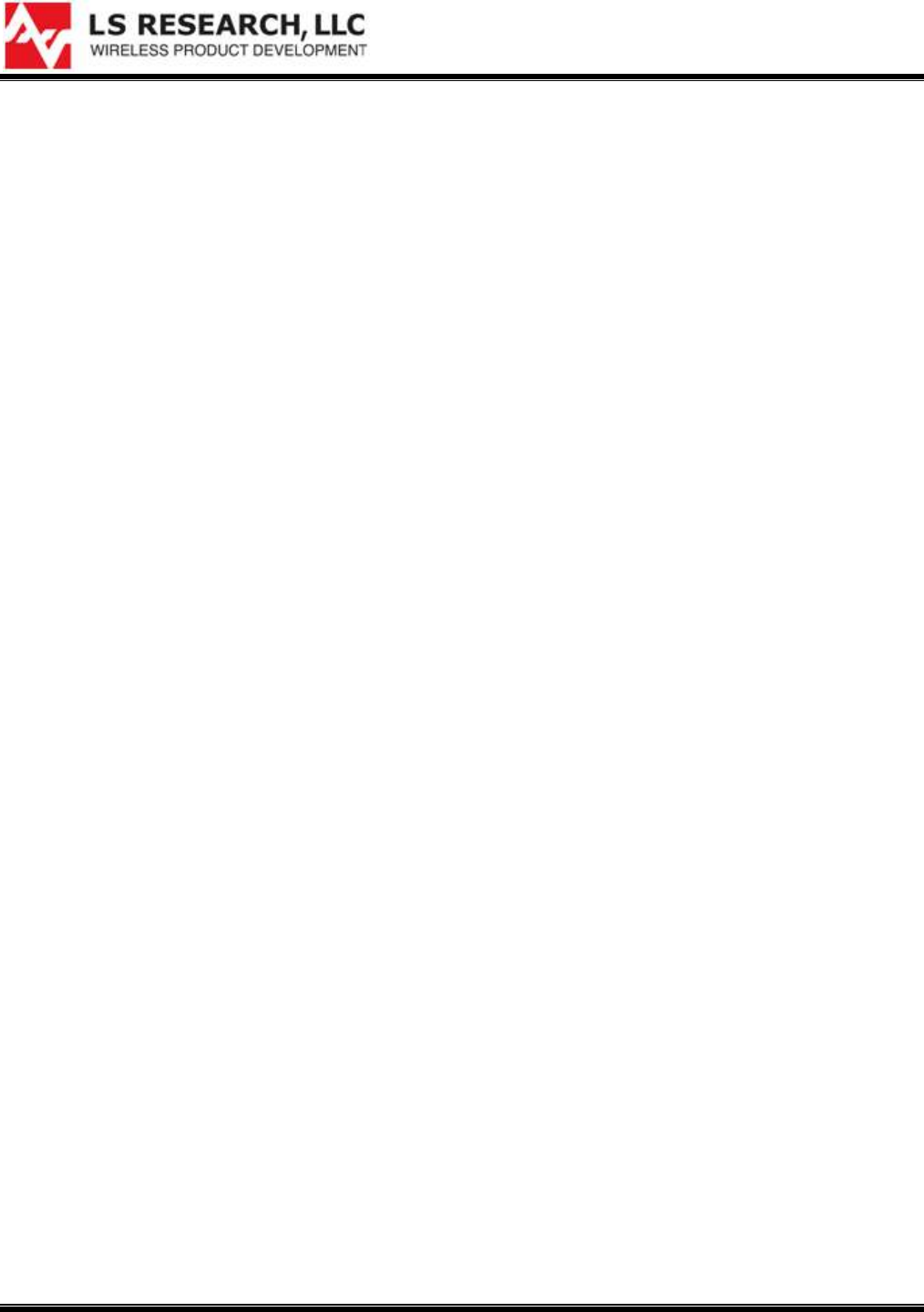
TiWi-uB1 Module
DATASHEET
The information in this document is subject to change without notice.
330-0132 Copyright © 2013 LS Research, LLC Page 21 of 22
EUROPE
CE Notice
This device has been tested and certified for use in the European Union. See the Declaration of
Conformity (DOC) for specifics.
If this device is used in a product, the OEM has responsibility to verify compliance of the final product to
the EU standards. A Declaration of Conformity must be issued and kept on file as described in the
Radio and Telecommunications Terminal Equipment (R&TTE) Directive.
The ‘CE’ mark must be placed on the OEM product per the labeling requirements of the Directive.
Declaration of Conformity (DOC)
The DOC can be downloaded from the LSR Wiki.
BLUETOOTH CERTIFICATION
The TiWi-uB1 module has been certified as a Controller Subsystem and has a QDID of B021230.
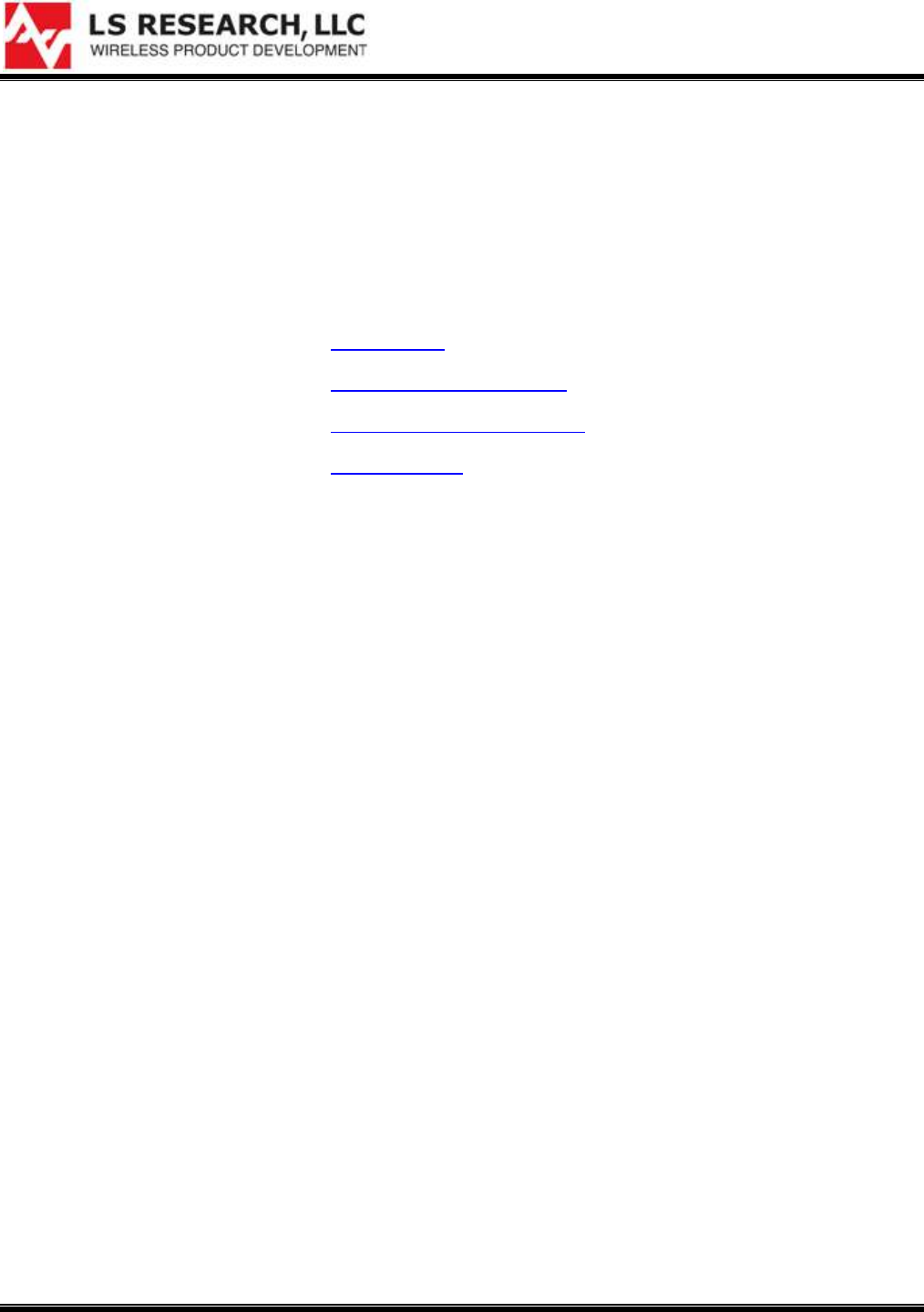
TiWi-uB1 Module
DATASHEET
The information in this document is subject to change without notice.
330-0132 Copyright © 2013 LS Research, LLC Page 22 of 22
CONTACTING LS RESEARCH
Headquarters LS Research, LLC
W66 N220 Commerce Court
Cedarburg, WI 53012-2636
USA
Tel: 1(262) 375-4400
Fax: 1(262) 375-4248
Website www.lsr.com
Wiki www.lsr.com/products-wiki
Technical Support www.lsr.com/products-forum
Sales Contact sales@lsr.com
The information in this document is provided in connection with LS Research (hereafter referred to as “LSR”)
products. No license, express or implied, by estoppel or otherwise, to any intellectual property right is granted by
this document or in connection with the sale of LSR products. EXCEPT AS SET FORTH IN LSR’S TERMS AND
CONDITIONS OF SALE LOCATED ON LSR’S WEB SITE, LSR ASSUMES NO LIABILITY WHATSOEVER AND
DISCLAIMS ANY EXPRESS, IMPLIED OR STATUTORY WARRANTY RELATING TO ITS PRODUCTS
INCLUDING, BUT NOT LIMITED TO, THE IMPLIED WARRANTY OF MERCHANTABILITY, FITNESS FOR A
PARTICULAR PURPOSE, OR NON-INFRINGEMENT. IN NO EVENT SHALL LSR BE LIABLE FOR ANY
DIRECT, INDIRECT, CONSEQUENTIAL, PUNITIVE, SPECIAL OR INCIDENTAL DAMAGES (INCLUDING,
WITHOUT LIMITATION, DAMAGES FOR LOSS OF PROFITS, BUSINESS INTERRUPTION, OR LOSS OF
INFORMATION) ARISING OUT OF THE USE OR INABILITY TO USE THIS DOCUMENT, EVEN IF LSR HAS
BEEN ADVISED OF THE POSSIBILITY OF SUCH DAMAGES. LSR makes no representations or warranties with
respect to the accuracy or completeness of the contents of this document and reserves the right to make changes
to specifications and product descriptions at any time without notice. LSR does not make any commitment to
update the information contained herein. Unless specifically provided otherwise, LSR products are not suitable
for, and shall not be used in, automotive applications. LSR’s products are not intended, authorized, or warranted
for use as components in applications intended to support or sustain life.